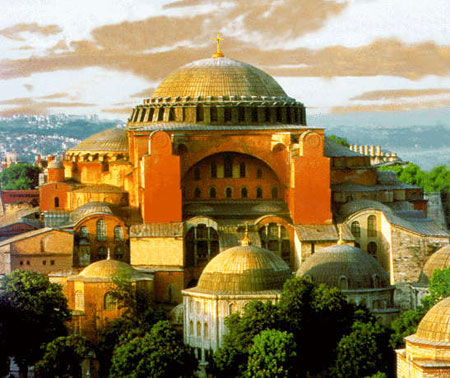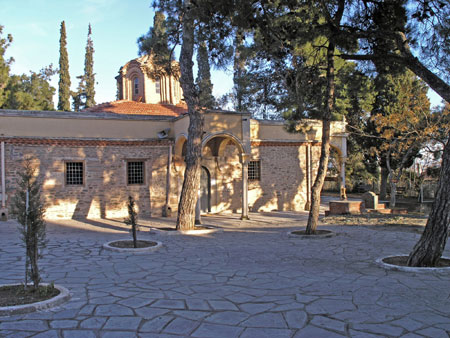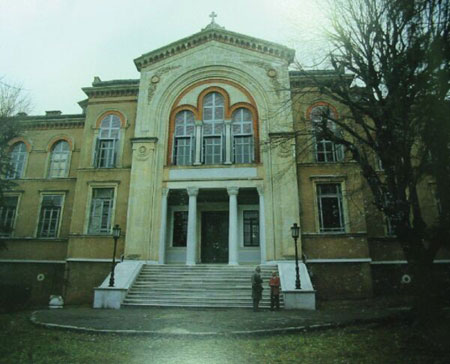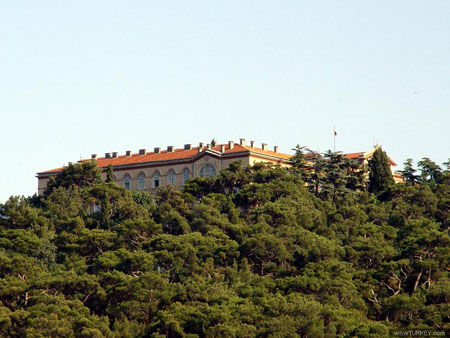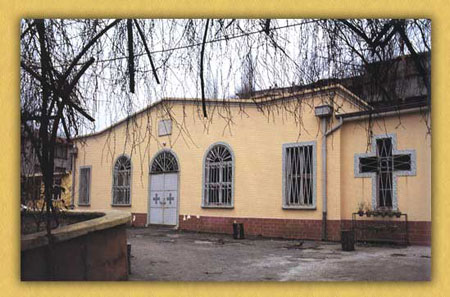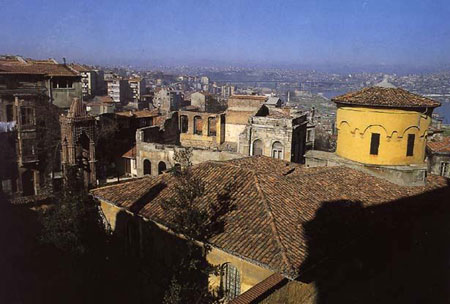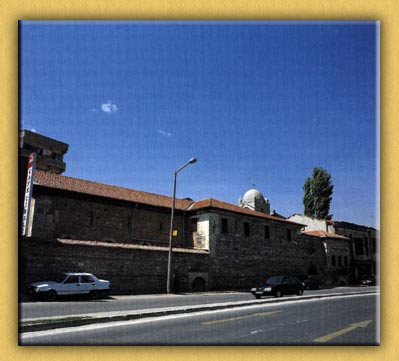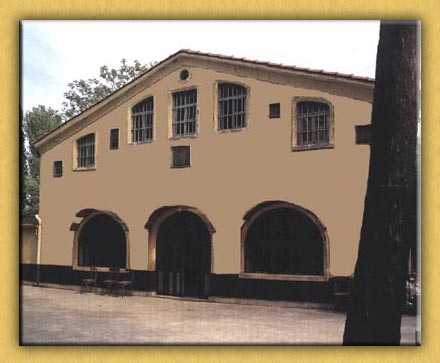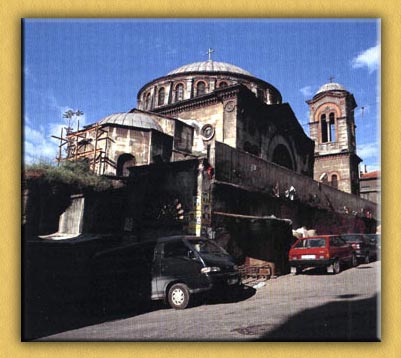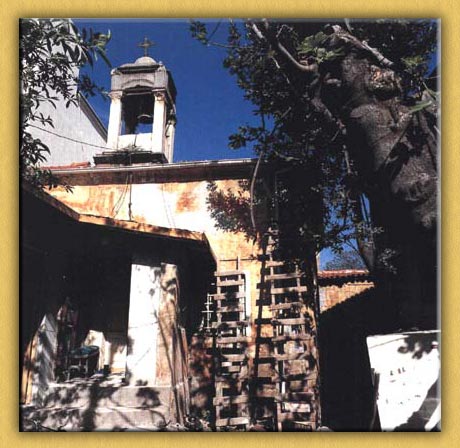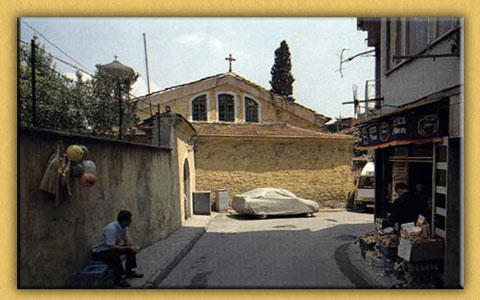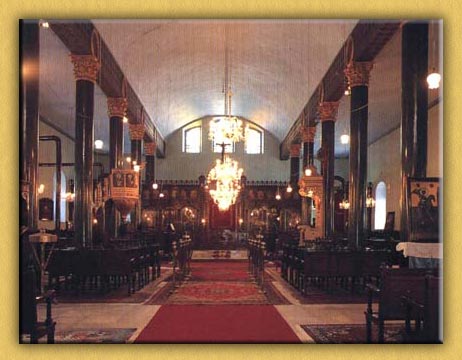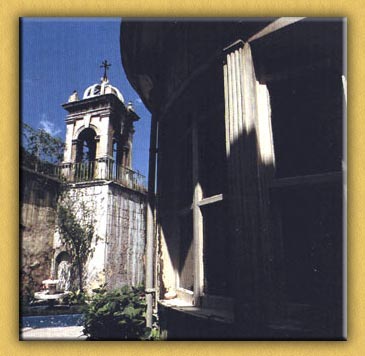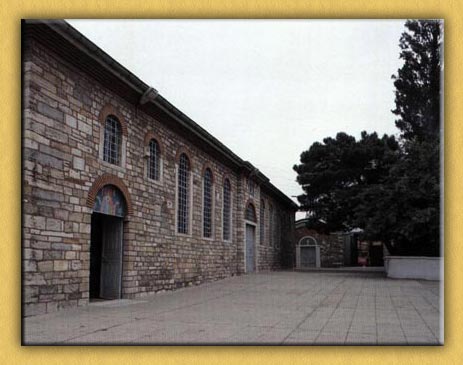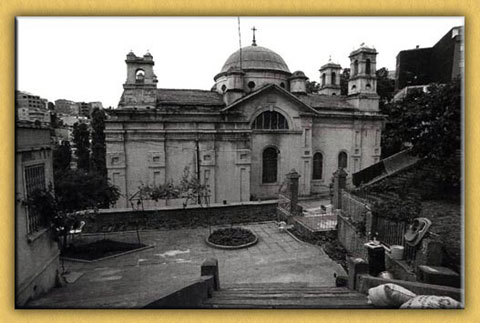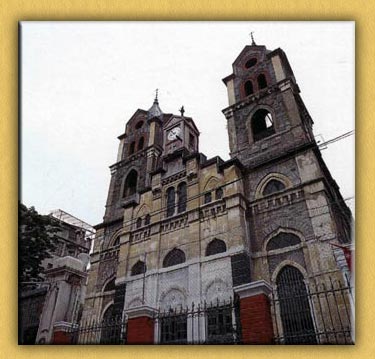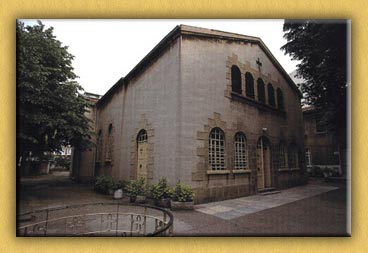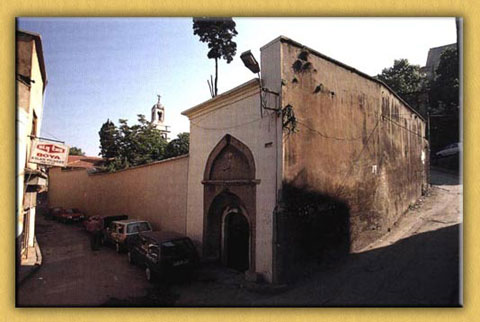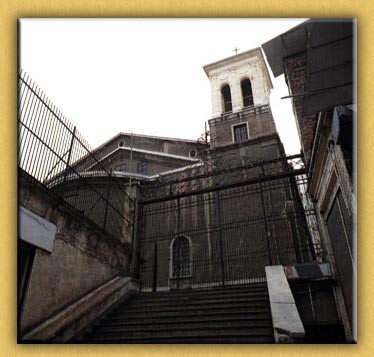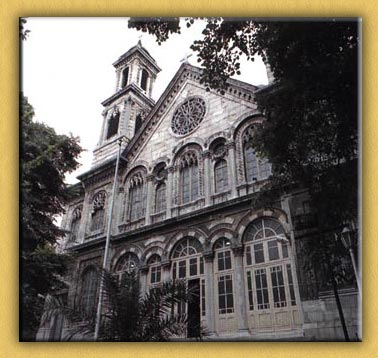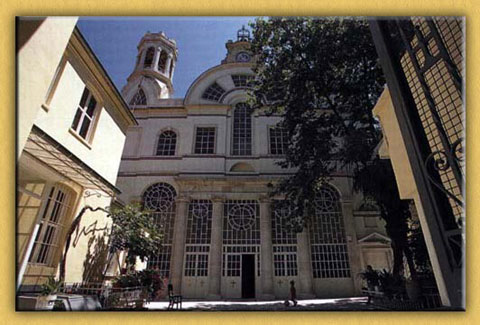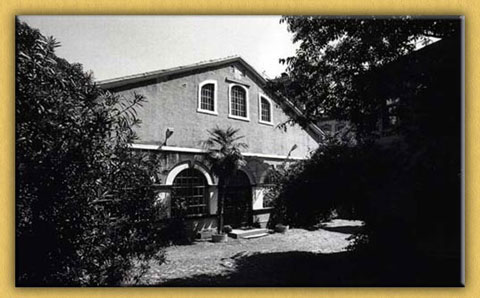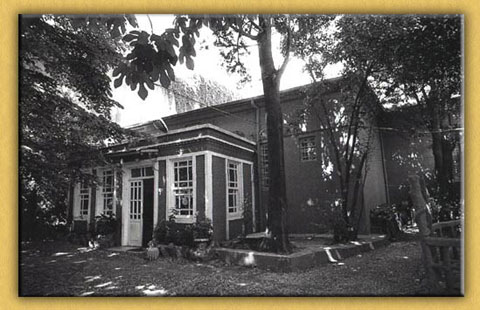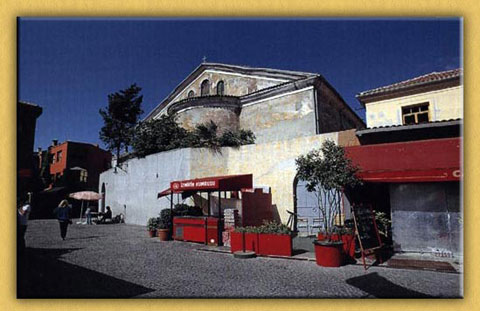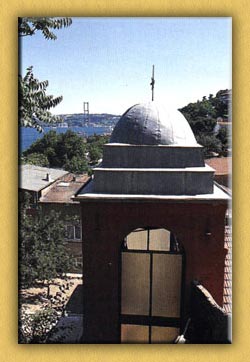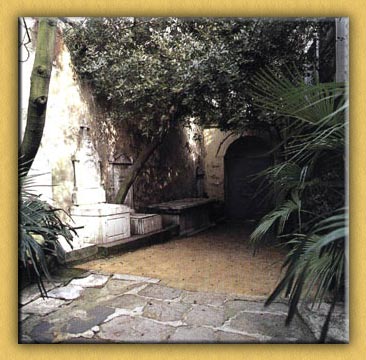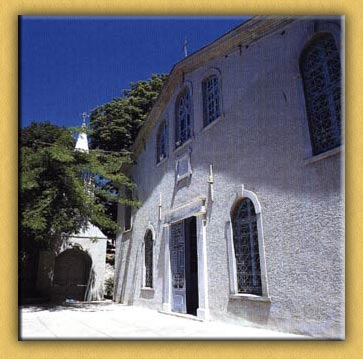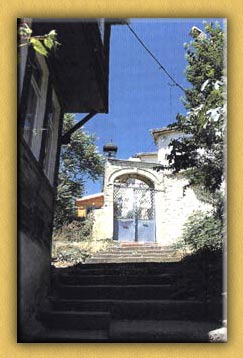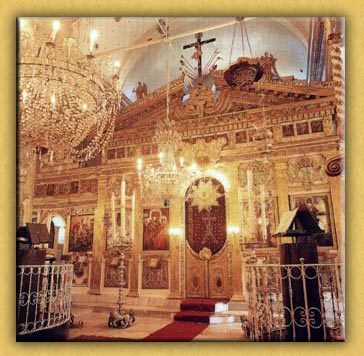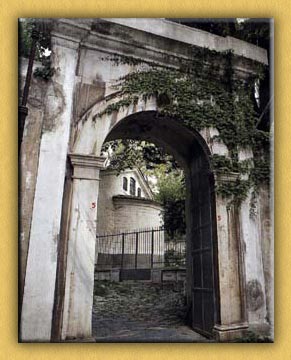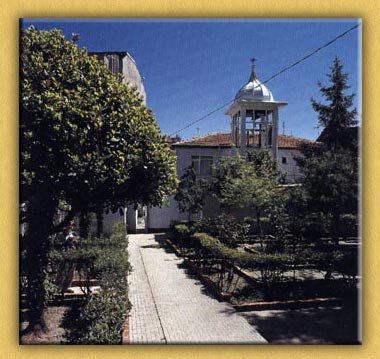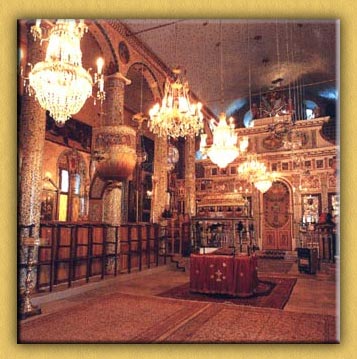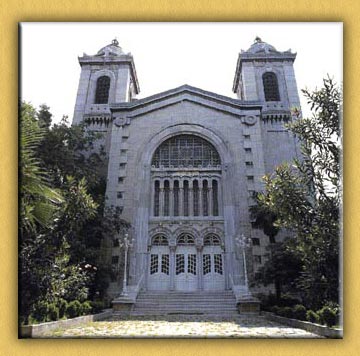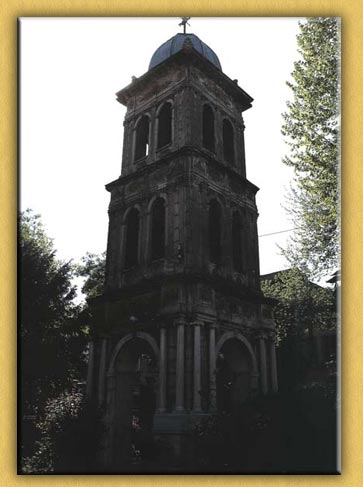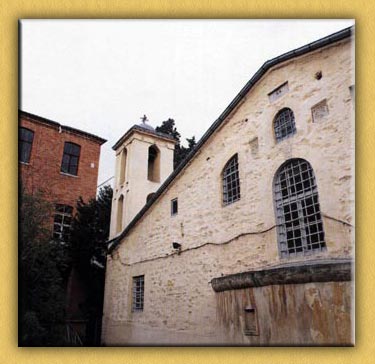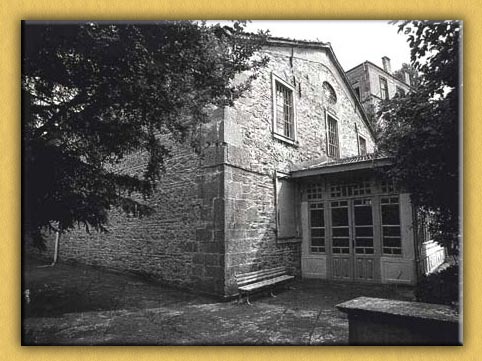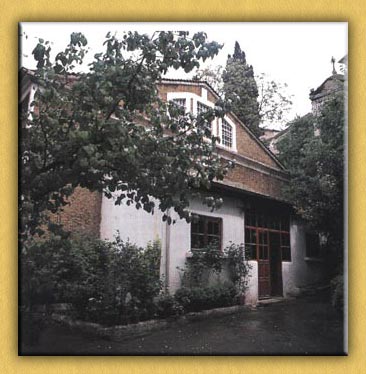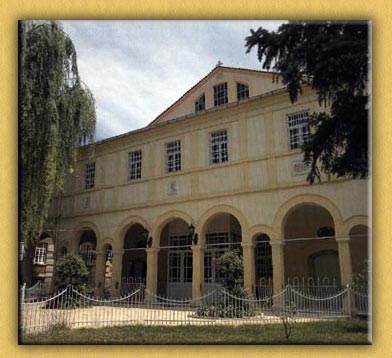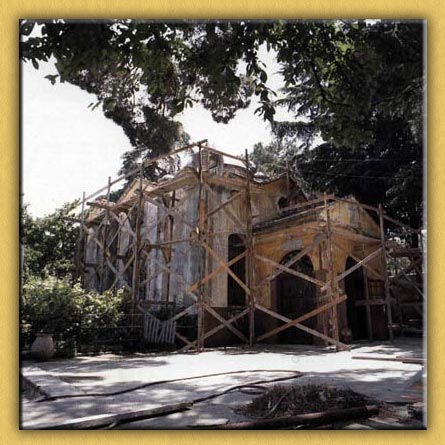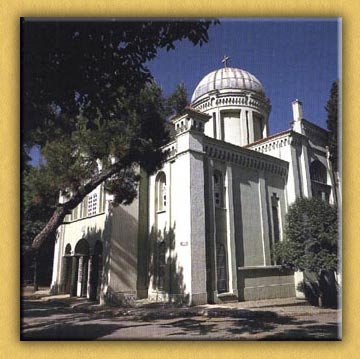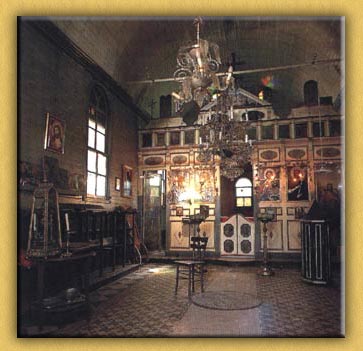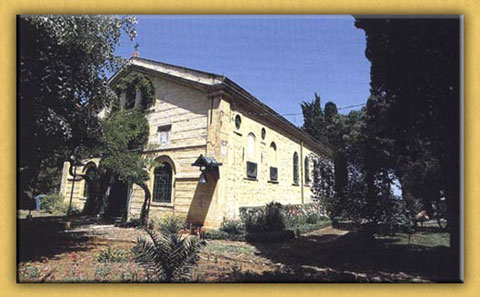Monasteries and churches of the Greek Orthodox Patriarchate of Constantinople
The Church of the Holy Wisdom - Hagia Sophia (???a S?f?a)
The Church of the Holy Wisdom, known as Hagia Sophia (???a S?f?a) in Greek, Sancta Sophia in Latin, and Ayasofya or Aya Sofya in Turkish, is a former Byzantine church and former Ottoman mosque in Istanbul. Now a museum, Hagia Sophia is universally acknowledged as one of the great buildings of the world.
History
Unfortunately nothing remains of the original Hagia Sophia, which was built on this site in the fourth century by Constantine the Great. Constantine was the first Christian emperor and the founder of the city of Constantinople, which he called "the New Rome." The Hagia Sophia was one of several great churches he built in important cities throughout his empire.
Following the destruction of Constantine's church, a second was built by his son Constantius and the emperor Theodosius the Great. This second church was burned down during the Nika riots of 532, though fragments of it have been excavated and can be seen today.
Hagia Sophia was rebuilt in her present form between 532 and 537 under the personal supervision of Emperor Justinian I.
It is one of the greatest surviving examples of Byzantine architecture, rich with mosaics and marble pillars and coverings. After completion, Justinian is said to have exclaimed, ?e?????? se S???µ?? ("Solomon, I have outdone thee!").
The architects of the church were Isidore of Miletus and Anthemius of Tralles, who were professors of geometry at the University of Constantinople. Their work was a technical triumph, even though the structure was severely damaged several times by earthquakes. The original dome collapsed after an earthquake in 558 and its replacement fell in 563. Steps were taken to better secure the dome, but there were additional partial collapses in 989 and 1346.
Justinian's basilica was at once the culminating architectural achievement of Late Antiquity and the first masterpiece of Byzantine architecture. Its influence, both architecturally and liturgically, was widespread and enduring in the Eastern Orthodox, Roman Catholic, and Muslim worlds alike.
For over 900 years the Hagia Sophia was the seat of the Orthodox Patriarch of Constantinople and a principal setting for church councils and imperial ceremonies.
In 1204 the cathedral was ruthlessly attacked, desecrated and plundered by the Crusaders, who also forcibly replaced the Patriarch of Constantinople with a Latin bishop. This event cemented the division of the Greek Orthodox and Roman Catholic churches that began with the "Great Schism" of 1054. Many of Hagia Sophia's riches can be seen today not in Istanbul, but in the treasury of St. Mark's Basilica in Venice.
Despite this setback, Hagia Sophia remained a functioning church until May 29, 1453, when Sultan Mehmet the Conqueror entered triumphantly into the city of Constantinople. He was amazed at the beauty of the Hagia Sophia and immediately converted it into his imperial mosque.
Hagia Sophia served as the principal mosque of Istanbul for almost 500 years. It became a model for many of the Ottoman mosques of Istanbul such as the Blue Mosque, the Suleiman Mosque, the Shehzade Mosque and the Rustem Pasha Mosque.
No major structural changes were made at first; the addition of a mihrab (prayer niche), minbar (pulpit) and a wooden minaret made a mosque out of the church. At some early point, all the faces depicted in the church's mosaics were covered in plaster due to the Islamic prohibition of figurative imagery. Various additions were made over the centuries by successive sultans.
Sultan Mehmed II built a madrasa (religious school) near the mosque and organized a waqf for its expenses. Extensive restorations were conducted by Mimar Sinan during the rule of Selim II, including the original sultan's loge and another minaret. Mimar Sinan built the mausoleum of Selim II to the southeast of the mosque in 1577 and the mausoleums of Murad III and Mehmed III were built next to it in the 1600s. Mahmud I ordered a restoration of the mosque in 1739 and added an ablution fountain, Koranic school, soup kitchen and library, making the mosque the center of a social complex.
The most famous restoration of the Hagia Sophia was completed between 1847-49 by Abdülmecid II, who invited Swiss architects Gaspare and Guiseppe Fossati to renovate the mosque. The brothers consolidated the dome and vaults, straightened columns,and revised the decoration of the exterior and the interior.
The discovery of the figural mosaics after the secularization of Hagia Sophia was guided by the descriptions of the Fossati brothers, who had uncovered them a century earlier for cleaning and recording. The Fossatis also added the calligraphic roundels that remain today. They were commissioned to calligrapher Kazasker Izzet Efendi and replaced older panels hanging on the piers.
In 1934, under Turkish president Kemal Atatürk, Hagia Sofia was secularized and turned into the Ayasofya Museum. The prayer rugs were removed, revealing the marble beneath, but the mosaics remained largely plastered over and the building was allowed to decay for some time. Some of the calligraphic panels were moved to other mosques, but eight roundels were left and can still be seen today.
A 1993 UNESCO mission to Turkey noted falling plaster, dirty marble facings, broken windows, decorative paintings damaged by moisture, and ill-maintained lead roofing. Cleaning, roofing and restoration have since been undertaken; many recent visitors have found their view obstructed by a huge scaffolding stretching up into the dome in the center of the nave.
Holy Patriarchal Stavropegic Monastery of the Vlatades
In a letter of Patriarch Matthaios, from the year 1400, to the Metropolitan of Thessaloniki, Gavriil, the Monastery in mentioned for the first time, under the name of the Monastery of the Pantokrator (=Christ the Lord of All), and reference is made to "Lord Dorotheos, who also indeed, established the monastery of the Pantokrator in the beginning". Other sources also mention that the Monastery is dedicated to Christ the Lord of All. The name which has predominated, however, has the founders in the plural: "Vlatadon" or "Vlat(t)aion", which means that there were at least two. In the oldest metropolitan document, which is kept in the Monastery Archive (1488), it is termed the Monastery of the Pantokrator of the Vlatadon or Vlataion. Besides, in manuscript no. 92 of the Monastery, there is another reference, probably from the 14th century concerning the venerable Monastery of the Pantokrator of the Vlatadon, while elsewhere in the same document, it is called the Monastery of the "Vlataion".
There were, indeed, two priest-monks known at that time who bore the name "Vlat(t)is", Dorotheos and Markos. They were friends and disciples of Saint Gregory Palamas, whom they followed to Constantinople, when he was called to appear before the synod which was to deal with the hesychast controversy and his theological differences with Barlaam the Calabrian. Having witnessed and shared the tribulations of Saint Gregory Palamas during the years 1341-1350, Dorotheos came with him to Thessaloniki and took up permanent residence in the city. He later occupied the metropolitan throne of Thessaloniki (1371-1379). Markos, who it seems was somewhat older, quickly left Constantinople for the Holy Mountain, where he lived as a monk at the Great Lavra. He, too, then came to Thessaloniki to be with his brother, in 1351.
An inscription set into the wall above the lintel of the west door to the Katholikon states that the Monastery was established "by the founders Vlateon, men of Crete". This inscription, however, is much later (1801) and there is no historical evidence to support it, as regards the founders' birth place.
It should be taken as read that the Vlatades were born in Thessaloniki. The Thessalonian patriarch Philotheos Kokkinos a childhood friend of the two brothers, says of them:" Both Dorotheos and Markos, who were brothers of the same family as well as being monks of rare worth, sprung from Thessaloniki the great, were the best of friends with Philotheos from childhood, fellows in spirit and in asceticism".
The Monastery must have been founded immediately after the enthronement of Saint Gregory Palamas, once the brothers had taken up residence in the town, perhaps in 1351, or even a little later. It was dedicated to the Transfiguration of the Savior, of which the light was for them, their teacher Saint Gregory and the Hesychasts the centre of their theological thought and life.
To this day, the Monastery tradition commemorates empress Anna Paleologina as founder, together with her husband Andronikos III, who had, of course, been dead for some time. Once Anna had taken up residence in Thessaloniki, in 1351, she remained there permanently as Governess until her death. A gate in the east wall of the city, close to the acropolis, which was built by her, bears an inscription with her name (1355). It was probably at this same time that construction work on the Monastery was being carried out.
The Monastery is called royal because it was established by a grant from Anna Paleologina and through a royal chrysobull, which has not survived, but which must have been issued in 1354, in the name of the emperor Ioannes Kantakouzenos and the empress Anna Paleologina, during the term as patriarch of Philotheos, friend of the founder. It is also called patriarchal and stavropegic because a patriarchal sigillium was issued for it, shortly afterwards, by the Ecumenical Patriarch Neilos, and the cross was places there. Another form of name which was used during the period of Turkish rule and is still used by many local people even today is Cavus Monastir. The most likely explanation of this name is that at some time a unit of Turkish troops was billeted there, with a cavus or sergeant in command. When the Turks captured the city of Thessaloniki for the first time, in 1387, they established a garrison in the acropolis, with a strong guard-post outside the south wall on the flat platform of the premises, and to watch the postern-gates which were in the walls at that point. The church was also taken over and converted into a mosque to meet the needs of the soldiers. After the second capture (1430), a guard-post must have been established there for the same reasons. The commander of the post, a "cavus", gave his name to the monastery. The grave of one of these commanders is to be seen in front of the south door of the Katholikon.
Another tradition is of great interest. It maintains that a certain guard commander damaged the church and the building installations a good number of years after the fall of the city. After this, he became gravely ill. Then, in a dream, he saw an elderly man who promised to cure him on condition that he repaired the damage to the church. The commander did so and was cured. From then on he was wont to go there to enjoy the view. He also did the Monastery a good many kindnesses and because of this the monks buried his remains outside the Katholikon.
All these traditions echo certain historical events, of which particular attention should be paid to the damage done to the monastery, the burial of his mortal remains outside the church and the privileges later accorded to the Monastery.
Papageorgiou P., at the end of the last century, expresses another view, which is worthy of note and may be linked to the above traditions. According to Papageorgiou, the church and the monastery took the name "Cavus" because they were next to the tower of Cavus Bey, which is part of the fortified walls in the upper town of Thessaloniki (Yedi Kule). On this tower there is the inscription recording the fact the Cavus Bey repaired the tower and settled there in 1431, one year after the capture of the city. Cavus Bey was on friendly terms with the Monastery and granted it a good many privileges, among which was that of immunity in 1446.
Quite apart from what has been written so far on this subject, it ought to be stressed that the Monastery of Vlatadon, because of its privileged positioning terms of location and security, would hardly have been left unused by the Turks. For this reason, it should not be linked only with the tower in the fortified walls, which, in any case, is not so close to the Monastery, but rather to the use of the premises by the Turks. It is this historical relationship which must be reflected in the tradition concerning the Cavus (commander) who fell ill and was cured after the Monastery was restored.
When the Turks captured Thessaloniki for the first time, in 1387, the Church of the Savior (Transfiguration), i.e. the Katholikon of the Monastery, was sequestered, as were the others, according to the testimony of Symeon of Thessaloniki: "And then, indeed, at that same time, the greatest number of the buildings of the churches fell to them, of which the first was the holy church of the Savior in the acropolis and as many others as were towards there and again as many monasteries hard by the acropolis , and these were, alack, trampled underfoot and the infidels rejoiced in them. Then later most of the religious buildings in the city were despoiled, while altars were demolished and sacred things profaned".
This passage concerns the Katholikon of the Monastery, and is confirmed by the traces of its conversion into a Muslim mosque. It seems that the entire monastery was confiscated, together with its lands, because it was a "royal" monastery, and according to the Turkish practice, every item belonged to the crown - even if only formally so - in lands which had been captured passed automatically into the possession of the sultan. They avoided seizing monasteries, although they did take over the churches and turned them into mosques. This sequestration must have remained in effect until 1403, when the Turkish garrison withdrew from the city, according to the treaty which followed the battle of Ankara. Despite this, however, two years earlier, in 1401, a document from the Patriarch Matthaios refers to the presbyter Theodotos as holding the Monastery of Vlatadon: ":the priest Theodotos, has put forward claim to become abbot in the monastic house of Saint Athanasios, which belongs to the Monastery of the Pantokrator, of which he is now in charge". This last item of information can probably be explained by the fact that the Turks canceled the sequestration of the Monastery of Vlatadon before the Treaty of 1403, because it had, in the meantime been proclaimed patriarchal and stavropegic and was no longer exclusively royal. This monastic house of Saint Athanasios, as a dependency of the Monastery of Vlatadon, had also been sequestered and then released from sequestration as a result of the freeing of the parent Monastery of Vlatadon. This is why Theodotos put forward his claims
When Thessaloniki was captured for a second time by the Turks (1430), the status of the Monastery was not affected, and it continued to function as a monastic foundation throughout the period of Ottoman occupation of the city. At the beginning of the 16th century, it appears to have housed the holy relics of Saint Gregory Palamas for a short time. When the church of Aghia Sophia (Holy Wisdom) in Thessaloniki, where the relics of the saint had been placed, was taken over by the Turks to be converted into a mosque, the relics were taken to the Monastery, where a small chapel in his name was built to house them. This no longer exists. After a short time the church was built which is now the metropolitan church of Thessaloniki and the relics were transferred there. The new church bore the names in common of Saints Demetrios and Gregory Palamas as the two patron saints of Thessaloniki. It was at precisely this time that the icon was painted representing both of them, which is kept in the sacristy of the Monastery.
At the time of the decline of the monasteries of the Orthodox Church, which occurred at the end of the 16th and throughout the greater part of the 17th centuries, the Monastery attempted to re-structure its possessions and retain its land holdings. The Ecumenical Patriarch Ieremias II, with a sigillium of his dated 1579 which is kept in the Monastery, stated that he had seen an old imperial chrysobull and had read a sigillium letters of his predecessors. Patriarch Neilos (1380-1388) and Ioasaf II (1555-1565), through which the monastery was recognised first as a royal and then as a patriarchal, while its autonomy was recognised and it was offered donations. With its own sigillium, Patriarch Ioasaf confirmed the title of the Monastery over what it had in its possession, especially over the dependencies. Despite this, it was unable to ensure a satisfactory level of functioning, because of the negligence of the monks as is reported in another sigillium published by the Ecumenical Patriarch Kyrillos Loukaris (1633), through which the Monastery was made subject to the Monastery of Ivirion on the Holy Mountain. This dependence was not of long duration, however. After fifteen years, Patriarch Ioannikios gave it back its sovereignty with another sigillium. Since then it has continued to function without hindrance down to our own days.
It seems that, from the first decadres of Turkish rule, because of the difficulty of maintaining coenobia (monasteries where the monks lived under a common rule) the system of administration through committees of wardens obtained in the Monastery of Vlatadon, too, until 1713. In the following years, one of the wardens, Anthimos Ypsilos, was elected abbot and retained the office for twenty-two years.
During this period, which lasted a hundred and twenty-two years (1714-1836), eight abbots were in charge of the Monastery. Prominent among them was Ignatios Konstantinou, who was in office for thirty-nine years (1755-1814) and proved very active, to the benefit of the Monastery. It was in his time that the buildings of the Monastery were renovated, especially the Katholikon.
The Same period saw the introduction of the system of lay wardens, who helped the abbots in the performance of their duties. During the period in office of Ignatios, Warden Ioannis Gouta Kaftantzoglou contributed to the rebuilding of the Monastery after years of stagnation. Members of the Kaftantzoglou family continued to give benefactions to the Monastery of Vlatadon until recently.
Later, for thirty years (1836-1866), the mechanism of administrating the Monastery through two-men committees of monks was in place. Since the monks often failed to administer and run the Monastery properly, however, this was taken over, on the initiative of the Ecumenical Patriarch, by lay wardens, prominent among whom were Athanasios Papageorgiou.
The Ecumenical Patriarch, in order to restore canonical order, later brought back the institution of the abbacy. Towards the end of the period of office of the first abbot, Nikeforos Demetriades (1866-1870), the dependency church of Saint Athanasios was taken over by the people who lived in the neighborhood, and successive abbots were unable to secure its release. During the time of his successor, Kallinikos Theologides (1871-1892), the income from the land holdings of the Monastery was granted by the Patriarchade to the Theological School in Chalke, and a new period of poverty set in.
During the period in office of Abbot Kallinikos Georgiades (1892-1923), it became clear that the building complex was largely in decay and some rough repairs took place.
The modern period begins with the liberation of Thessaloniki (1912) and found the Monastery with the same abbot. During the time in office of his successor, Ioakeim of Iviron, a scholarly man (1923-1940), the new building of the abbot's quarters was constructed, as were the sacristy and the chapel of the Mother of God, the expenses being met by Professor Anastasios Mysiroglou.
On the other hand, however, the Monastery lost its extensive lands in Kalamaria, which were expropriated to be given to the landless or to be used for other social purposes. At this time it was a meeting-place for scholars and academics of the city. During the period in office of his successor. Pangratios of Iviron (1940-1966), the Patriarchate passed a set of rules for the internal administration of the Monastery, which applied for a short time.
In the last twenty years, the following have occupied the position of abbot:
Stylianos Charkianakis, at present Archbishop of Australia (1966-1975)
Apostolos Papaioannou, Metropolitan of Ainos (1975-1976)
Ezekiel Tsoukalas, Metropolitan of Pisidia (1976-1977)
Nikodemos Anagnostou, at present Metropolitan of Ierissos, the Holy Mountain and Ardamerios (1977-1980)
Theodoretos Tsirigiotis, Bishop of Elaia (1980-1985)
Panteleimon Rodopoulos, Metropolitan of Tyroloe and Serention, Professor and former Rector of the University of Thessaloniki (1985).
Holy Monastery of Koutloumous, Mount Athos
Dedicated to the Transfiguration of the Saviour, this monastery, the sixth in the hierarchy, was probably erected in the first half of the l2th century A.D., according to a document dating from A.D. 1169. Its founder was probably a monk from Africa (koutloumous the saint from Ethiopia). Decimated by the raids of the Catalans, it found a fervent supporter and generous patron in the person of Ioannis Vladislav, Prince of Hungro-Wallachia (second half of the l4th century). The monastery acquired prestige and power through its designation as a patriarchal establishment (A.D.1393), its annexation of the Monastery of Alypios (A.D.1428) and gifts from many emperors.
In A.D. 1497 it was destroyed by a great fire, and again in A.D. 1767 and A.D. 1870. It was supported in its times of trial by laymen and clerics from many parts of the Orthodox Christian world who made generous contributions.
Holy Patriarchal Stavropegic Monastery of the Holy Trinity in Halki - Holy Theological School of Halki
The Holy Theological School of Halki (also Chalki) was, until its closure by the Turkish authorities in 1971, the main school of theology and primary seminary of the Ecumenical Patriarchate of Constantinople. It is located on Halki (in Turkish, Heybeliada), one of the Princes' Islands in the Sea of Marmara.
The Orthodox Church's activities on the island of Halki are traced back to the Byzantine period when the Monastery of the Holy Trinity was founded on the island. A date for the founding of the monastery is not known although the establishment of the monastery has been associated with Photius I, Patriarch of Constantinople (r. 858–861 and 878–886). Subsequently the monastery fell into ruin during the Turkish period.
The school of theology was established on the grounds of the old monastery after Patriarch Germanos IV visited the island in 1842. Then, with the approval of the Turkish authorities, the operation of Holy Trinity monastery and the school of theology began on October 1, 1844 with a special ceremony that marked the occasion.
An earthquake in June 1894 destroyed all the buildings of the monastery and theological school except for the chapel. This stopped the operation of the school. The present day facilities were built, with financing by Pavlos Skilitsis Stefanovick, by architect Periklis Fotiadis, and operation of the school and monastery was re-inaugurated in October 1896. Major renovation of the facilities also took place in the 1950s, including the monastery church.
The Holy Theological School of Halki was established to meet the educational needs of the Patriarchate of Constantinople as well as of the Orthodox Church in general. Since its establishment in 1844, the school has passed through a number of organizations. Initially, between 1844 and 1899 the school operated with four high school grades and three theological grades. During the period of 1899 and 1923 the high school grades were discontinued and the school functioned as an Academy of five grades. Between 1923 and 1951 the school reactivated the high school grades as originally established in 1844. In 1951 the educational program was again modified to consisted of three high school grades and four theological grades. This arrangement continued until 1971 when the school was closed after passage of a law that prohibited operation of privately owned schools of higher education in Turkey. It has remained closed since although the facilities have been visited and used by Orthodox friends and faithful.
The theological facilities include the Chapel of the Holy Trinity, sports and recreational institutions, dormitories, an infirmary, a hospice, offices, and the school's library with its historic collection of books, journals, and manuscripts. The students at Halki included not only a large number of native born Greeks, but Orthodox Christians from around the world, which gave the school an international character.
Numerous Orthodox scholars, theologians, priests, bishops, and patriarchs graduated from Halki, including the current Patriarch Bartholomew I and his immediate predecessors, Patriarchs Demetrius, Athenagoras, and Maximus V. Many patriarchs, bishops, and former teachers of the school are buried on the grounds.
In 1971, the seminary was closed by a Turkish law that forbids private universities from functioning in Turkey. In 1998, the Turkish government ordered the disbandment of the Halki board of trustees, until international criticism of Ankara's decision persuaded the Turkish authorities to reverse their order.
Halki has received international attention in recent years. In October 1998, both houses of the United States Congress passed resolutions that supported the reopening of Halki. The American President Bill Clinton visited Halki during his visit to Turkey in 1999 and urged Turkish President Suleyman Demirel to allow reopening of the school. The European Union has also raised the issue as part of its negotiations over Turkish accession to the EU.
The Patriarchate had hoped that promises from the Turkish government to allow the seminary to reopen would be enacted, this has not come to pass as of yet.
Patriarchal Church of Saint George (Phanar)
The Patriarchal Church of St George, Phanar (Greek: Kathedrikós Naós tou Agíou Georgíou, ?a?ed????? ?a?? t?? ????? Ge??????; Turkish: Aya Yorgi) is a Greek Orthodox cathedral church in Istanbul, Turkey (formerly Constantinople). Since the early seventeenth century it has been the seat of the Ecumenical Patriarchate of Constantinople, the senior patriarchate of the Eastern Orthodox church.
History
After the fall of Constantinople to the Muslim Ottoman Turks in 1453, the population of Constantinople became largely Muslim. The Phanar district, which is northwest of the center of old Constantinople, became the center of Greek Christian life in the conquered city. About 1600, Patriarch Matthew II moved the patriarchate to the church of the female monastery of St. George in the Phanar district, making it his cathedral church. During the following years the original church was much modified.
In 1614, Patr. Timothy changed and enlarged the church. In the late seventeenth century Patr. Callinicus II the Acarnan modified the church again. Early in the eighteenth century the church was severely damaged by fire. Patr. Jeremias III finally received permission in 1720 from the Turks to begin rebuilding the church. The reconstruction effort, begun by Jeremias III, was continued under Patr. Paisius II. A major fire in 1738 again severely damaged the church, and permission to rebuild it was not obtained until 1797.
The reconstruction, begun in 1797 by Patr. Gregory V, largely produced the structure of the church that exists today. Little remains of the original building. The plan for the church was a basilica with a nave and two aisles with three semicircular apses in the eastern end. A narthex was built across the western end. The aisles are defined by colonnades that separated them from the nave. A synthronon is arranged at the back of the altar as a semi-circle of seats along the curved wall of the apse for the senior clergy, with the patriarchal throne of marble in the center.
Patr. Gregory VI made further changes to the church in the late 1830s. Principal among these changes was the raising of the roof to its present height. Also added was the neo-Classical marble doorway that makes the exterior in front of the church different from the Byzantine style of most Orthodox churches in the region. During the reign of Patr. Joachim III in the late nineteenth century extensive remodeling of the interior of the church was conducted. In 1941, the church was again damaged by fire. For political reasons this damage was not repaired until 1991.
Among the treasures in the church are the marble throne which is believed to date from the fifth century and the relics of Sts. Gregory the Theologian and John Chrysostom. These relics were among the loot taken from Constantinople during the Fourth Crusade in 1204 that were returned to the patriarchate in 2004 by Pope John Paul II.
With the Greek Orthodox population in Istanbul greatly reduced, the Cathedral Church of St George, while relatively small for the cathedral of the senior hierarch of the Eastern Church, serves today mainly as the symbolic center of the Ecumenical Patriarchate and a center for pilgrimages for Orthodox Christians.
The address of the cathedral is Fener Rum Patrikhanesi, Sadrazam Ali Pasa Cadesi, Fener 34220, Istanbul, Turkey.
Church of the Virgin of Vlachernae
The Church of Panagia Blachernae (full name in Greek: Te?tò??? t?? ??a?e???? (pr. Theotókos tón Blachernón); Turkish name: Meryem Ana Kilisesi) is located in Istanbul, in the district of Fatih, in the neighbourhood of Ayvansaray, along Mustafa Pasa Bostani Sokak. It lies a few hundred meters inside the walled city, at a short distance from the shore of the Golden Horn. The building is protected by a high wall, and preceded by a garden.
The church is near the northern tip of the walls of Theodosios built by the Empress Pulcheria (ca. 450-453), and her husband, Emperor Marcian (450-457). They had the church built on the site of a sacred spring, which was a place of pilgrimage near the shore of the Golden Horn (known as Ayvansaray today). Inside is now the best known and most celebrated sanctuary to the Virgin Mary in Constantinople. Emperor Leo I (457-474) completed the church by adding the "Hagiasma". He also built the "Hagion Lousma"
Emperor Leo I also built the circular pareklision Hagia Soros (chapel), next to the church to contain the holy robe and girdle of the Virgin Mary, brought from Palestine in 458 (or 473). The chapel of the Virgin's robe was covered in silver and considered a "reliquary of architectural dimensions." Lay people were not allowed inside but could pray in the main church.[4] This very shrine housed the miracle-working icon of the Blachernitissa.
In 625-626, Constantinople was attacked by the Avards. Emperor Heraclius (575-641) campaigned against the Persians, however, the icon was carried in a procession along the city walls and so the saving of the city was attributed to the intervention of the Theotokos. In order to protect the sanctuary, and the city from such a siege, Leo I added the famous quarter of Blachernae in 627, with its venerated church, whose image was now considered the palladium of Constantinople. The circumference of the walls were then, and still are, eleven to twelve miles. By this stage, the church of Blachernae had around 75 endowed clerics.
During the iconoclastic period, and according to tradition, the icon disappeared and was then found hidden behind a wall during renovation works in 1030.
The church was burnt down in 1070 and rebuilt by the year 1077 either by Romanos IV Diogenes (1067-78) or Michael VII (1071-87) and then destroyed again by fire in 1434. The church, at this stage, was connected to the Palace of Blachernae by a stairway. After the fire, nothing remained of the fire apart from the Sacred Spring.
In 1867, the modern church was built and further additions have since been made to the structure. It is said, that the Akathistos was first chanted at this location and a special marble plaque, inscribed with the Akathistos verse, a celebrated Byzantine hymn, to the Theotokos, has now been placed above the Hagiasma. In addition, there are four wall paintings by the famous painter Eirenarchos Covas (1964)
To this very day, the spring is reputed to have therapeutic powers.
Church of the Dormition of the Virgin, Mouchlion
The church of Panagia Mouchliotissa is located at the Phanar quarter, between the Megale Schole and the Joachimian Girls School, not far from the Metochion of the Holy Sepulchre. In older days the origin of the church's name had given rise to a minor philological argumentation. S. Kugeas maintained that the name derived from Mouchlion, at Mystra, the inhabitants of which had settled in this area of the Phanar quarter in 1242. H. Gregoire, M. Lascaris and Gennadios Metropolitan of Heliopolis, believed that it is the Greek rendering of the Slavonic word mogyla. Indeed, the church was known by the names «St. Mary of the Mongols or Mougouls» and more commonly «Panagia of Mouchlion or Mouchliotissa» (Paspatis).
The history of the church provides the answer. Maria Palaeologina, daughter of Michael VIII Palaeologus (1261-1282), was given in marriage to the Khan of the Mongols, Hulagu or Abagu (Pachymeres). After the death of her husband she returned to Constantinople and founded the convent and church, probably in 1285. The founding of the convent is mentioned in the Paris Codex Gr. 2625.
According to written sources, the convent of Mouchlion was built on the site of an earlier monastery dedicated to the Theotokos Panagiotissa, which had been ruined, apparently by the Latins (Pasadaios). Maria Palaeologina bought the grounds with the vineyards and whatever structures existed, repaired some of them, erected new ones, and organized the women's convent. She endowed the monastery with relics, valuable vessels, manuscripts, lands in Constantinople and Rhaedestus, spending all her fortune. This information is obtained from a synodical document of 1351 (Miklosich and Müller, vol. I, 312-15), according to which the Ecumenical Patriarchate decreed the restitution to the monastery of the entire fortune seized by the usurper brother-in-law of Maria Palaeologina, Isaac Palaeologus-Asen. Asen, whom Maria had appointed by a chrysobul trustee of the monastery's properties after her death, used the revenues to his own advantage and the convent was facing dire poverty.
After the Conquest, Mehmet II made a present of the church to the Greek architect Christodoulos, as a reward for the construction of the Mosque of the Conqueror (Fatih Camii) at the site of the demolished church of the Holy Apostles. The firman issued by Mehmet the Conqueror saved the church from being converted into a mosque under Selim I, and the Panagia Mouchliotissa has remained an Orthodox church to this day.
The church, of irregular plan, stands within an enclosure with a small courtyard. Its most remarkable architectural feature is the elegant dome supported by four piers, though its size is rather disproportionate to the dimensions of the building. The apse to the east has survived, while traces of a second apse to the north reveal the old triconchial plan of the sanctuary. The entire south side was enlarged in later times to create a rectangular chamber with a cross-vaulted roof. Some traces from a representation of the Last Judgment are the only remnants of the old painting decoration of the church. An annotation on the manuscript of Suidas's Lexicon (Paris Codex Gr. 2625) informs us that the church was painted by Modestus in the late 13th century.
In addition to the mosaic icon of Panagia Mouchliotissa, dated by Soteriou to the late 13th-early 14th century, another four post-Byzantine icons are notable: St. Paraskeve (1.35x0.40 m.) St. Euphemia (1.35x0.40 m.), the Three Hierarchs (1.25x0.60 m.) and the Sts. Theodoroi (1.27x0.54 m.). The belfry in the courtyard is of later date.
Holy Shrine of the Virgin Vefa
The Church of the Mother of God and the Aghiasma known as Vefa stand opposite the Comnenian monastery of the Pantocrator. In Byzantine times the quarter was called “Ta Sophrakiou”, but later it became Vefa Meidan, taking the name of a distinguished Turkish poet, Seyh eb ul Vefa.
According to legend, Constantine Palaeologus, the last emperor of Byzantium, is buried in Vefa Square in an "invisible and insignificant" grave, besides which is the grave of the Arab who killed him. Tradition relates that as he fell Constantine cried out "µ' ?fa?e?!" ("You've done for me!"), the name 'Mepha' and thence 'Vefa' deriving from his last words.
The church was demolished after the Fall in 1455 and a garden was laid out on the site. In 1750 the garden was bought by an Epirote one of many thousands who left the craggy mountains of continental Greece to seek their fortune in the City. His daughter had a dream that there was an Aghiasma on the property and followed her father to Constantinople to persuade him to search fork. Excavations in 1755 revealed the passage-way and reservoir as well as a marble icon dated 1080. On the death of the Epirote and his daughter the Aghiasma passed to his heirs. Over the years it was purchased from them by the Macedonian Educational Brotherhood of Constantinople, which carried out extensive repairs and alterations. Twelve steps lead down from the church to the Aghiasma. It is said that in addition to a number of ex-votos preserved there, the marble icon, now broken, is kept there in a bronze casket.
Here too, as at Blachernæ, on the first day of every month Turks, both men and women, wait patiently in line with Christians to collect some holy water which they sprinkle about their homes and shops. On New Year's Eve the queue stretches to even a kilometre in length.
Church of Saint Nicholas Tzivaliou
The earliest known references to the church complex, consisting of the Church of Saint Nicholas, the Chapel of Saint Charalampos and the Aghiasma, occur in Turkish documents of 1724 and 1837. Writing about these sultanic enactments, Gedeon states they are proof that a church stood on the site at a time prior to the Fall of the City.
A typical example of the manner in which the Christian communities of Constantinople are organised -the church standing in an enclosure protected by tall courtyard walls and surrounded by school buildings, meeting-rooms and philanthropic and cultural associations- the Saint Nicholas complex, renovated in 1998 by the Nikolaos Vardinoyannis Foundation, is in a fine state of preservation.
The approach from the north is down a stairway, for the level of the coast road has been raised. The church covers the greater part of the north-eastern area of the enclosed space, while the Aghiasma is situated in the south-eastern.
The Chapel of Saint Charalampos stands in the southern sector. The walling and the architecture, which incorporates Phanariot stonework, stem directly from Byzantine styles. The exterior on the Keratios (Golden Horn) side is of unusual interest since it is one of the few examples of a building that links late Byzantine with post-Byzantine architecture.
Church of the Virgin Paramythia - 'Vlach Saray'
The «most beautiful ruins» in the City, if one takes the liberty in speaking of ruins to call them beautiful.
The entire district that includes the church, close by the Metochi of the Holy Sepulchre in the Phanar, was once owned by the rulers of Wallachia. Their palaces, the "Saraya of Vlachia ", stood in the same quarter and so the church became widely known as Vlach Saray. The Constantinopolitan Ghikas, Soutsos and Cantacouzinos families used to attend this church, among them omnipotent individuals like Michail Cantacouzinos 'Seitanoglou' (Son of the Devil). The latter was a close friend of the Grand Vizier Sokoli (1560-1575) and holder of the salt monopoly. Cantacouzinos was destined one day, when his fortunes were in decline, to be hanged on the order of Mural I?? from the great gate of the palace he owned at Anchialo.
The church has a long and tragic history, undergoing frequent destruction and restoration. It was burnt down in 1640 and again in 1729. Rebuilt in 1730 it was saved, as if by a miracle, from another conflagration at the end of the 18th century. It was again rebuilt in the mid 19th century only to be wholly destroyed by fire in 1970.
The visitor who manages to penetrate the ruined area, now that the level approach from the rear is no longer feasible because the neighbourhood grocer has turned it into a storage space for his wooden crates, will feel his heart miss a beat as he reflects that for a decade at the end of the 16th century the Patriarchate was established here and the local Synod of 1595 met in this place.
Leaving the site for the Golden Horn, the thought crosses the mind that it would be a blessing indeed if this venerable ruin were restored from its very foundations.
Church of the Dormition of the Mother of God Valinou
Following the sea-walls along the shore of the Golden Horn, before reaching the Church of Saint Demetrios Xyloportas one arrives at the Church of the Mother of God Valinou.
Built and rebuilt like many others after the great fires which devastated the district, it is in an abject condition today. Externally the building is in urgent need of conservation, while the interior is slowly but steadily being destroyed by damp.
The attribute Balinou takes one back lo Magister Pavlinos who held office under Theodosios fl. nicknamed 'the Small' (409-450).
The church, whose finances were in a pitiful state, was on the point of being sold when Meletios Pigas, Patriarch of Alexandria, rescued it by settling its debts in 1597. Later it came under the protection of the rulers of Wallachia. Nonetheless, its economic well-being, though at one time it did take a turn for the better, can never have been on a sound footing, for Gedeon notes that "the church treasury gave meagre sums to works of public benefit".
There is no mention t? be found of a school, he continues, and attributes this to the likelihood of the children of the parish attending classes at the adjacent school of Saint Demetrios at Xyloporta.
Church of Saint Demetrios Xyloportas
The Church of Saint Demetrios Xyloportas, "known as 'tou Kanavi'," writes A.G. Paspatis, "was an ancient church with a dome, its interior decorated with mosaics. This church was destroyed and the present timber-roofed building was erected in the early years of the 18th century".
Notwithstanding, no other source mentions a Byzantine church -"it is never mentioned in Byzantine writings"- and the only connection which can be made is through the attribute 'Kanavis', linking it with the patrician Nikolaos Kanavos who was living at the time of the first conquest (1204).
Renovated successively in 1730, 1835, 1933 and I960, as evidenced by inscribed tablets on the walls, it was restored most recently in 1995, at the expense of G. Vassilopoulos.
The church is of considerable historical importance as it accommodated the Patriarchate for three years. For a period of about one hundred and forty years after the Fall of the City in 1453 the Patriarchate had no fixed abode. Once Aghia Sophia had been converted into a Muslim shrine the scat of the Great Church of Christ was for a while at the Church of the Holy Apostles, but it was later required to abandon that noble Byzantine church and to be received at the Church of the Virgin Pammakaristos. About a century afterwards it moved from there to the district of the Golden Horn. It left the Church of Saint Demetrios Xyloportas for the Virgin Paramythia to end up eventually, in 1601 or 1602, at the Monastery of Saint George (in the Phanar district) where it has remained ever since.
Church of the Virgin of Souda, Egrikapi
The Church of the Virgin of Souda Egrikapou, a timber-roofed basilica built on the same site where once the 13th-century Byzantine Church of Saint Nikitas had stood, close to the Palaces of Blachernæ and the Egri Kapou Gate, was renovated in 1999 by Ioannis Andropoulos. However, the wooden building and the entrance to the complex on one side of the church had already been totally destroyed by fire.
We know that the church was set fire to in 1640 and again in 1728. An official Ottoman document refers to the latter event and permits repairs to be made on the grounds that "since the conquest this church has remained in the possession of the Orthodox Greeks ".
There used to be a Greek school and a medical centre and asylum within the enclosure of the Church of the Virgin of Souda.
Beneath the altar of the church is an Aghiasma, approached down fourteen stone steps. It is a space with a vaulted roof and marble floor and contains a marble reservoir. According to Gedeon it is a remnant of a Byzantine ablutionary.
The asylum in the church complex, described in an inscription as
serving indeed as a free hospital
a new Siloam for all who attend it,
was resorted to by the unfortunate insane, but ceased its mission in February 1839.
Church of Saint George Antiphonitis, Phanar
Of impressive size, this three-aisled, stone-built and timber-roofed basilica is a handsome building of 1830. It has a very fine narthex and an iron bell tower. The Church of Saint George Potiras, recently restored by two brothers, Christos and Ninos Elmacioglou (1998), once belonged to the family of "the Logothetis (Chief Secretary) of the Great Church, Georgios Potiras".
The church stands at the far end of a delightful garden with shady trees. The courtyard is protected by an enclosure wall of particularly line workmanship.
Gedeon confirms there is no earlier mention of the church than one dating to 1648. Nevertheless, it is possible it served briefly as a patriarchal dwelling when the Patriarchate was evicted from the Pammakaristos.
The attribute 'Antiphonitis', which should be 'Christ Antiphonitis', arises from a delightful legend. In bygone times, it is said, there was a usurer who insisted that another Christian owed him money. The poor man attempted in vain to prove it was not so. In the end, despairing, he made a proposal: "Let's go to the icon of Christ. If your conscience allows you to, repeat those lies there ". The usurer went along with him, and when the icon heard him it contradicted him ('antiphonise') and the poor man was vindicated.
There are some fine marble reliefs and some inscriptions. An enormous earthenware jar is embedded in the right-hand wall of the narthex to receive offerings of olive oil. Next to it is an inscription with an exhortation:
Christian, whenever you bring an offering lo the altar
Your pious hand should pour the olive oil herein
In Photira 1.12.1883
Church of the Virgin of the Heavens, Salmatobruk
The level of the kalderimia, the stone-paved streets of Constantinople rises whenever they are repaired, for the new layer of flag-stones is laid over the old. That is why the doorway into the courtyard of the Church of the Virgin of the Heavens, whose feast day is 15 August, is now half-buried.
Regrettably, both the church itself and the school and other buildings within the enclosure, like the 'Romaic' or Greek school opposite, are now in bad repair.
The attribute «Kyria ton Ouranon», Queen of the Heavens, may be explained as a Greek rendering of the Armenian word 'Takavor' or 'Takouaran'. These are names by which Armenians refer to the Virgin, and as the old church had once belonged to a noble Armenian family its dedication was changed first to 'Ta Koronia' and later to 'Kyria ton Ouranon'.
The church complex is cared for by Vassilis Trapzanoglou and his wife Marianthi. Born in Trabizond, Trapzanoglou has been a church-warden for forty years on end and remembers the times when the parish consisted of forty families, of which only one remains today: his own.
The church is timber-roofed and the nave or central aisle is tunnel-vaulted. It possesses a fine templo and, in the north aisle, an Aghiasma. The sacred fountain-head is of marble and has two spouts, it is incised with a cross and the inscription "Aghiasma of Saint Kyriaki", below which are the words "Dedicated by L. Toptsoglou 1959".
Church of the Virgin Hadzergiotissa, Tekfursaray
On the Sixth Hill, the highest in the City, at the centre of one of the most destitute quarters and only a stone's throw from breath-taking Chora Monastery is the church complex of the Virgin Hadzergiotissa. Gedeon states that "it suffered the well known fate of neighbouring churches, being destroyed by fire and rebuilt at the same time as they were. The present-day building, begun in 1836, was completed in January 1837".
Having passed through the entrance one descends a few steps to reach the level of the paved courtyard in which the church stands. Inserted in the west facade is a marble relief with an icon of the Virgin and the date 1837.
Immediately behind the sanctuary is the Aghiasma of Saint Paraskevi in a vaulted underground chamber.
The property is now in a distressing state of disrepair. If it were not for the constant efforts of the verger and parish priest, whom the Patriarch honoured with the dignity of Syngelos on 10 June 1999, and the few remaining parishioners, matters would be far worse.
Damp, a sly adversary, is rotting the timbers; that the plaster is cracking and peeling is all too evident on the wall next to the stairway up to the gynæcium, the women's gallery.
The unheated, locked-up buildings are doomed so long as they lack the constant presence and warmth of human beings. Nonetheless, here, as with almost all the churches in Constantinople, irrespective of whether the congregation is large or small, everything is spotless and cared for, and the oil lamps are kept burning.
Church of Saint George, Edirnekapi
The Church of Saint George Edirnekapou lies close to the Adrianoupolis Gate (Edirnekapou) and only a short distance from the shrine of Mihrimah, daughter of Sultan Suleiman I the Magnificent.
In one sense the church is the successor of an earlier Byzantine monastery destroyed by the Ottomans in 1555 in order to make way for the shrine of Mihrimah. The church was erected by special permission of the Sultan. "Permission having been granted", wrote Skarlatos Byzantios, "twelve years later [...] they built the still extant timber-roofed Church of Saint George which they named a Monastery in memory of the one that first stood there [...J".
Inscriptions inform us that the church was repaired in 1726 and completely rebuilt in 1836.
As Gedeon tells us, at one time the church was remarkably prosperous because only a short distance beyond the Adrianoupolis Gate there used to be windmills owned by Greeks and Bulgars. The guilds of all those who had anything to do with flour, such as millers and corn merchants, bakers, bread-roll sellers and Rusk-makers, in one way or another took the church under their protection.
Church of Saint Kyriaki, Kontoskaliou - Kumkapi
Among the populous Greek neighbourhoods of Kontoskali, Vlanga and Hypsomatheia close to the Propontis, the Sea of Marmara, there are about ten church complexes that still have a life of their own.
As we know it today, the Church of Saint Kyriaki was built in the late 19th century to the design of Pericles Photiades, who was the architect also of the Zographeion School. The earliest reference to the Church of Saint Kyriaki Kontoskaliou was made by the representative of the Russian Czar, who visited it in 1583.
The church survives in fairly good order though damp has caused damage here, too, especially in the dome and the sanctuary where there are also cracks in the masonry.
The imposing octagonal building with its dome and belfry belongs to that bygone age in which Greeks of Constantinople enjoyed the status of "equality before the law". Wealthy Greek communities were able to erect magnificent Houses of Prayer and the buildings that so often clustered around them - the schools, assembly-halls, and association premises were no less splendid.
The neo-classical, stone school house opposite the church is falling into ruin, while the building that was once the community centre is now a repository. Behind the stacks of merchandise one can make out the stage of a small theatre with fine woodcarved decoration.
The scene in the adjacent buildings is, however, quite different. There the priest-in-charge, Meletios Sakkoulidis, has his offices. A tireless collector of books printed on Constantinopolitan presses, a scholar of ecclesiastical and community history, and faithful to the traditions observed by a deeply religious cleric, he ministers to the churches the Phanar has entrusted to his care (Saint Kyriaki, The Virgin of Hope and Saints Theodore Vlangas) and assists visitors in their contacts with the spiritually vibrant capital of the Pan-Orthodox world.
Here on Sundays and great feast-days the most recent migrants - Georgians, Romanians and Ukrainians -, settled in the densely populated districts around the Church of Saint Kyriaki, participate in the Communion service. They live in old middle-class residences with woodcarved ornamentation on their impressive facades, but now on the point of collapse.
Church of the Virgin of Hope, Kontoskaliou
Of the four large churches in the Kontoskali district which burnt down in 1660, Saint Nicholas' and Saint John's were wiped out and never rebuilt, but the Church of the Virgin of Hope was not only rebuilt in 1680 through the intervention of the Russian ambassador Nikita Alexievich, but also was provided by the Russian government with an annual grant of money (M. Gedeon).
In 1719 it was again reduced to ashes. It is not known if that church had already been replaced before the great fire of 1762, only to be destroyed once more. What is certain is that another church was consumed by fire in August 1865, and for the next thirty years the parishioners observed their religious obligations in a timber-built chapel erected within the church enclosure.
On 4 January 1895, as soon as the special firman or permit allowing its rebuilding had been issued by the Sultan, the foundation-stone was laid of the present church, considered one of the most beautiful of the extant churches in Constantinople. It lies only a few paces distant from the similarly impressive Church of Saint Kyriaki.
A typical example of the architecture of its time, it is a fine building with staid and severe baroque features, a structure erected by the hands of Thracian craftsmen living in the parish. The church asserts its presence, its mere size and the harmony of its composition, its outstanding decoration and the distinction of its overall conception evoking a response from the onlooker.
In all probability the Virgin of Hope stands on the same site once occupied by the 14th-century Monastery of Certain Hope, a foundation associated with great Palaeologan families such as the Philanthropinos.
Sadly, the present slate of the church is far from satisfactory. Dilapidations, chiefly through damp, are considerable, as photographs of the Pantocrator and wall-paintings clearly illustrate. Judging also from the condition of the exterior, the sum required for the church 'a restoration will be a large one.
Churches of Saint Menas and of the Divine Ascension, Hypsomatheia
The Church of Saint Menas, built on an eminence close to the railroad track, used to hold its annual feast on the name-day of Saints Papylos and Karpos, names conflated to read Papylokarpos and then corrupted to Polykarpos. It is probable that a church stood on the site as early as the 10th century. A subterranean chamber of the church, built in 1833 by the architect Giosigmazis, as recorded in an inscription on marble, contains the Aghiasma of Saint Menas, the origin of the change in the name of the church from Saint Polykarpos to Saint Menas.
The church is triple-aisled, timber-roofed and stone-built; it is in a fair state of preservation, except for the belfry which is in danger of collapse. The surrounding area is choked with weeds, but the church courtyard is always clean-swept and neat, with flowering plants in garden pots; and the sanctuary lamps are kept lit. Access to the Aghiasma is from the east side of the narthex. The marble fountain has three spouts.
The timber-roofed basilica of the Divine Ascension, surrounded by a high enclosure wall, lies in the same neighbourhood. The fate of churches in the City of Constantine is a shared one. The Church of the Divine Ascension is a typical example: it has been built and rebuilt over and over again.
Formerly the church celebrated on the name-day of the Virgin Chrysalithini. The earliest written evidence of the church is a patriarchal letter dated 1566. The church was burnt down in 1660 and rebuilt, only to be reduced once more to ashes in 1782. It was erected yet again and kept in repair until 1832. At the time of Patriarch Constantios, the church, according to a marble inscription over the main doorway, acquired its present form through the desire, zeal and eagerness of «Christ-worshipping believers.» There is an Aghiasma behind the sanctuary with a raised marble well-head and a basin, also of marble, with two spouts. Both the church itself and the caretaker's house are in need of maintenance.
Church of Saint Nicholas, Hypsomatheia
The ancient Byzantine city is conjured up as one walks around the wails of Hypsomatheia wherever one meets them or down the narrow streets, particularly in this district where they are part of the layout of a city that has scarcely changed over the centuries.
Saint Nicholas' is a small church and merely a hundred or so metres separate it from Saint Menas'. It stands on the lower side of the main street.
The outbreak of the 1821 Greek War of Independence and the hanging of the patriarch in Constantinople were followed by appalling expulsions that lasted almost a decade and inflicted enormous harm upon the Greeks of the City. This explains why it is that one so often reads of churches being rebuilt in the years immediately after 1830. They are the churches destroyed during those ten years when it was impossible to repair them so long as the terror lasted, one of the harshest periods of persecution.
We know from inscriptions that this church of Saint Nicholas was among those renovated in 1834, as ever through the love and zeal of the Christian community.
Church of Saints Constantine and Helen, Hypsomatheia
During the first years that followed the Fall of Constantinople in 1453 the district of Hypsomatheia was populated by Christian Karamans or Karamanlides from Cappadocia. The church complex is situated close to the famous but now ruined Monastery of Studion, founded in 463. This monastery was occupied by the order of the Akoimitoi (Acoemetac) monks, 'the sleepless ones', an austere order which exercised a strong influence over ecclesiastical affairs in the fifth and sixth centuries and later during the period of Church controversies. The Akoimitoi introduced 'continual worship' in the form of 'perpetual psalmody', professing that «hymns chanted to God must never be disrupted.»
The church is the focal point of the parish. For this reason there are within its enclosure other buildings such as administrative offices, soup kitchens, refreshment rooms, and the Photiades School. Photiades was the uncle of Constantine Cavafis, the Alexandrian poet, who lived for a time in his relative’s house close to the church.
With its vast narthex, wall-mounted reliefs and beautiful templon, the church edifice is relatively well preserved, but in this instance, too, damp is causing problems. Yet everything shows signs of being cared for and the courtyard is spotlessly clean. The chairman of the parish council is always ready to offer visitors tea with bread-rings from the adjacent bakery.
Church of Saint Nicholas, Topkapi
Close by the Saint Romanos Gate is the Church of Saint Nicholas built over the ruins of earlier churches which probably date to the Macedonian dynasty (867-1059). Inscriptions state that the church was erected in 1831.
One is tempted to venture that if a future historian had no other evidence to go by than the marble inscriptions so frequently found on the walls of Constantinopolitan churches - inscriptions of which most refer to rebuildings and repairs and few to the dale of a church's foundation - he could perhaps reconstruct, not so much the history of each church, but rather the history of the Greeks in the City.
These inscriptions, misspelt though they are, tell us of the "desire and zeal of the parishioners and of kyr Sophronios head priest of the church'' and, elsewhere, of "the parishioner gardeners and superintendent grocers". They are a revelation to those seeking knowledge of the remarkable communities of Greeks in Constantinople.
On the left side of the narthex is the Aghiasma of Saint George. The well-head and sacred water basin are marble.
Church of Saint Dimitrios, Tatavla
One of the largest and most beautiful of churches, the Church of Saint Demetrios is in Tatavla, the most Greek of all the districts of Constantinople; the Turks used to call it Giaour Tatavla ('Giaour' being a term of reproach for Christians).
Skarlatos Byzantios notes that the name of this "most lovely and most salubrious" district used to be Saint Demetrios, but Tatavla prevailed because the country villas and stables (stavloi) of the Genoese residents of Galata were situated there.
The district was first settled during the reign of Suleyman I. The earliest inhabitants must have been the shipwrights who worked in the Tarsana, the sultan's dockyard, at Keratio; they were mainly prisoners from the Mani, Aegean islands and Crete.
When the Turks converted the first Church of Saint Demetrios into a mosque, the people of Tatavla removed the icon and placed it in the small Chapel of Saint Athanasios at the top of the hill. It was then that the chapel was renamed Saint Demetrios.
The chapel was enlarged and in 1726, the date given in a marble inscription on the south wall of the church, it was renovated from the foundations up.
An enormous five-aisled basilica with a domed central aisle or nave, a templon and pulpit of elaborate workmanship, and an episcopal throne with lions at its base, the Church of Saint Demetrios is a striking edifice.
There are office buildings around the edges of the courtyard, while the schoolhouse is prominent behind the church.
Opposite the church complex lies the 'Heracles Sports Club of Tataoulon ', the first sports club founded in the Ottoman Empire. It includes vast halls and courts, a reading room, dining-room, offices and the 'Zacharopheios Basketball Court'. In places where the plaster work has peeled from the wall one can make out traces of wall-painting. To the right and left of the entrance are two large marble plaques inscribed with the names of the benefactors of Greek descent. They provide evidence of the history of the locality.
Church of Saint Athanasios, Tatavla
Till the mid 18th century Tatavla was one of the most distinctly working-class neighbourhoods - a legendary neighbourhood nonetheless, known indeed as 'legendary Tatavla'. It was remarkable for its dashing young men (Bishop Pamphilos Melissinos dubbed them "spirited and mettlesome "), young men who would not hesitate to take on the gendarmes who overstepped the bounds and became excessively oppressive, and for its famous fire-fighters and renowned housewives: 'a Tatavlian housewife' was high praise for the mistress of a house.
As the years passed Tatavla's composition changed. Gradually it became the most influential and bustling community in the City, for in 1793 the people of Tatavla, through the mediation of Kapudan Pasa, succeeded in obtaining a firman which prohibited persons of other nationalities and religions from settling on the Hill.
In 1929 a fire, whose origin is still obscure, swept through the neighbourhood. It was only then that the prohibitive edict was violated. The new settlement was named Kurtulus, a Turkish word meaning liberation, but the Greek population stayed on: until 1964 it numbered around twenty thousand.
When the Hatti Humayun was promulgated in 1856 the right to religious tolerance was strengthened. Thereupon, in 1858, this flourishing community, which now included merchants, intellectuals and tradesmen, inaugurated the second church in Tatavla, the Church of Saint Athanasios, which stands on the far side of the hill.
Built on the hill slopes, the stone church is of fine workmanship. As Skarlatos Byzantios observes, it was the first church permitted since the Fall of the City to be erected with a dome and bell-tower. Till then the architectural norm was a basilica without a dome, while bell-towers were forbidden.
There is an Aghiasma in the Chapel of the Virgin Zoodochou Pigis (Fount of Life) situated below the church.
Church of the Annunciation of the Mother of God Propodon Tataoulon
The parish of the Virgin Evangelistria Propodon was created in 1857, having first been detached from the parish of Saint Demetrios. It lies in a poverty-stricken and rather ill-famed district on the lower slopes of the hill, close to the water-course of Kasimpasa fed by both surface and sewage waters.
The Church of the Annunciation is built where an earlier wooden chapel, known as Tahta Kilise, used to stand. The new church with its lead-covered dome and two belfries "was completed in 1893 and consecrated the following year".
On the wall above the lintel over the west door is a marble plaque inscribed:
Through the liberal contributions of all Orthodox Christians,
from both the City and elsewhere, and Societies,
the most venerable Church of the Annunciation of the Mother of God
was completed to the design of Petrakis D. Meimarides in the year 1893
and consecrated in the year 1894 in the reign of Patriarch Neophytos VIII.
Attached to the north aisle and situated in a stone-built chapel is the Aghiasma of the Nativity of the Mother of God. On the right of the templon in the chapel is the stairway leading down to the Aghiasma. The marble basin fills through four spouts.
Church of the Twelve Apostles, Ferikioy
Before the district had been settled and attached to Pera, a mansion stood here belonging to Madame Feri to whom lands, then unoccupied, had been granted in recognition of the services rendered by her late husband, a Frenchman and a palace doctor.
The Greek community came into being only in the mid 19th century. Once the essential sultan's permit had been obtained, the foundation-stone of the Church of the Twelve Apostles was laid. The date of this event is not known, but it must have been several years before the building's completion in 1868, for the church is a large one.
There is a marble inscription (the only one that has been found) above the lintel over the west door of the church. It reads:
This church of the wise Apostles
has been erected where no church stood before
and from its very foundations
through the generous gifts of the faithful
during the patriarchate of Gregorios VI
In the month of May 1868
The Aghiasma in an old building in the gardens at Tsendra lay at a distance of about two hours journey on foot. It used to celebrate on 26 July, the name-day of Saint Paraskevi, and "was adorned by sacred and most ancient icons displayed here and there". (N. Atzemoglou).
The renovated building within the church enclosure now houses the “Cultural and Arts Association of Feriköy” and the “Amateur Drama Club”, whose members are exceptionally keen.
Church of Saint Paraskevi, Pikridion
The work of rebuilding the Church of Saint Paraskevi at Hasköy, a church of Byzantine origin according to Skarlatos Byzantios, was begun in 1724 at the expense of Konstantinos Vrangovanos, hospodar of Hungaro-Wallachia, and of other wealthy Phanariots. It was completed in 1752 during the patriarchate of Cyril V.
The inscription recording the event is on the wall of the gynæcium and reads:
This church was made resplendent at the expense of
Konstantinos Semantor of Hungaro-Wallachia Brankovanos
out of reverence for God Champion and Martyr Saint Paraskevi
In the year 1692.
The Aghiasma is on a hill lying among Greek, Turkish and Jewish cemeteries. Gedeon insists it is part of an ancient aqueduct. It is built of stone, and to reach it one has to cross a vaulted cave twenty-five metres deep.
Church of the Presentation of the Virgin, Stavrodromion
At Stavrodromi in the most central part of the so-called European city, the part we all know as Pera ('Yonder'), an entire block is occupied by the Church of the Presentation of the Mother of God and the cluster of buildings around it: offices, priest's house, assembly halls, places of refreshment.
Outside the enclosure, with the party wall between them and the ecclesiastical buildings, are rows of shops. Throughout the day the place is overrun by noisy crowds - shopkeepers, workers and shoppers. The large iron gates leading into the church complex are kept open in daytime to assist the movement of the populace, but they close in the evenings.
When Galata and other neighbourhoods at the foot of the hill were no longer able to absorb the thousands of Christians who swarmed into the City from all around it was only natural that they should expand to the higher ground and new residential districts should gradually be established there. The church ministering to this densely populated and wealthy parish was built in 1804, some years after the end of the Russo-Turkish war of 1787. The foundation stone was laid by Prince Dimilrios Mourouzis. The first building, a modest chapel, was erected in just one night with the help of parishioners, both men and women.
It is said that in order to obtain the permit for the buildings, since no church had previously stood on the site, Mourouzis concocted a ploy. He paid two Turks to begin a quarrel. When they were seized and led away to the karakol, the local police station, and were asked where it was they had been spoiling for a fight they replied, as agreed, "There where the church of the Greeks used to be". The same ruse was resorted to a short while later with the help of other puppets and thus, on the strength of the evidence given in both incidents, the Sultan's permit to 'rebuild' was secured.
The church acquired its present form in as late as 1893. It is a huge, imposing five-aisled basilica with a magnificent baroque templon, while the subject matter of its iconography is borrowed from the Palaeologan Monastery of the Chora.
The scale and grandeur of this, the earliest of the 19th-century churches built in Constantinople (it is associated with the Zographeion School) will impress the present-day visitor. This is especially true if he is fortunate enough to be in the church on its feast day, the 21st of November, when the cream of the Greek community is gathered there to attend the service at which the Patriarch officiates in person. Surrounded by wonderful woodcarvings, purple velvet hangings and silver candelabra of the finest workmanship he will perhaps begin to understand the meaning of the phrase "the Hellenism of the City", that is, the spirit and the legacy of the Greek communities of Ottoman times.
Church of the Holy Trinity Taksim
With its splendid mansions, grand houses and palaces occupied by embassies, Pera, where wealthy Greeks used to live, was once a prosperous district. After the founding of the Church of the Presentation of the Mother of God, yet another church was founded, one that is now the largest still functioning.
This last was the Church of the Holy Trinity in Taksim, a vast western-style building whose foundation-stone was laid in 1867 by Patriarch Gregorios VI.
Leading members of the Greek community, among them the Imperial Architect Vassilakis Efendi Ioannides, George Zarifis, E. Eugenides, P. Stefanovic Skylitsis and G. Koronaios, secured the loan required to complete so large a building.
Millas states that during the consecration of the church thirteen years later Skylitsis, Eugenides and Zarifis, rather than make any other donation, placed the promissory notes, which they had redeemed, in the collection plate.
Apart from the churches built in Pera there were founded schools. City and Greek schools, girls schools and foreign language and commercial schools and, in addition, literary associations for women 'a education, student clubs and charitable societies.
Two of the schools, the Zographeion and the six-storey Zappeion Girls School, attended by the Greek youth of Constantinople, set the standard and gave evidence of the strength, both economic and cultural, of the Greek community in the City.
Reference must be made to the Aghiasma of Saint George, with its marble basin fed by three spouts, in the south part of the narthex of the Church of the Holy Trinity.
Unfortunately this stately church is now much damaged and work on its conservation must begin very shortly.
Church of Saints Constantine and Helen, Stavrodromion
The Church of Saints Constantine and Helen has been repaired and restored by the Commercial Bank of Greece and was reconsecrated on the saints feast-day, 21 May 1999.
This, too, is a large and richly embellished church. Completed in 1861, the ceremony of Thyranoixia, the Opening of the Portals, was held on 9 April of that year.
The Aghiasma of the church is at Kasimpasa and lies in a vegetable garden belonging to private owners. Manouil Gedeon mentions that its feast used to be held on 26 July and that on that day the parish priest would bless all visitors.
The keys of the Aghiasma are kept by a Muslim neighbour who obligingly opens it to pilgrims.
Church of the Dormition of the Virgin, Diplokionion - Besiktas
Wherever you be in Constantinople you are aware of the sea holding everything in its embrace: the Sea of Marmara, the Golden Horn, the Bosphorus in its serpentine course, bays and inlets and small headlands; and huge trees, lofty trees, features of Thracian territory, and shrubs and hydrangeas everywhere - and surrounding them all is water.
Sailing up the Bosphorus one passes Dolmabahçe Palace before reaching Byzantine Diplokionion at Besiktas.
The Church of the Dormition of the Mother of God at Besiktas was rebuilt in the late 17"' century, but in May 1730 it was renovated "at public expense" by the Christian community of Diplokionion "through the mediation of a notable, a doctor of great repute, Kyr Thomas of Testambouza from Kydonia in Crete ". These and other details are recorded in a wall inscription above the left door of the narthex "in perpetual memory of all". The church was rebuilt for the third time in 1833.
As in nearly all the parishes, there were educational establishments and schools here, too. In 1906, for instance, a seven-form City School for Boys and a seven-form Girls School were active at Besiktas.
The church is now surrounded by a market-place, but within enclosure walls. The courtyard is pebbled and the church is fairly well maintained.
Church of the Nativity of the Mother of God Palaiou Baniou, Diplokionion -Besiktas
On leaving the Church of the Dormition Diplokioniou - Besiktas and taking the road to Mesachoro we come to another church which, though small and humble, has an interesting history.
It seems that it was here, in bygone times, that the katergaroi used to attend services. They were the slaves who laboured in the naval dockyards and, chained to the benches, rowed the galleys. The etymology of the attribute 'Baniou' must be sought in this fact: in French 'bagne' means katergos, one condemned to penal servitude.
Skarlatos Byzantios writes that the church offers the right to asylum "and for this reason most undesirable marriages were performed by the priests officiating there ".
The church was last renovated probably around 1864.
Church of Saint Phokas, Mesachori - Ortakioy
Mesachoro: an historic place. It was here that Basil the Macedonian built the renowned Monastery of Saint Phocas, a monastery razed at the time of the Fall to make way for the awesome fortress of Laimokopias (the Cutthroat), now Roumeli Hisar.
The Church of Saint Phocas is a building of 1856. An official Turkish document preserved in the church archives permits its erection by Greeks and suggests that the first church in that locality beside the Bosphorus was founded in about 1560. The same document defines the site of the burial-ground and the lands that were to belong to the church.
Enlarged in 1693, the church was destroyed by fire in 1719. A small wooden chapel was built there in 1720 and replaced by a similar structure in 1819 and finally in 1856 by the stately imposing edifice that stands there today. It should be noted that the first congregation of this impressive church consisted of poor people: farmers, market gardeners, fishermen and boatmen, in some respect cut off from the outside world. Now Mesachoro has grown into a rich suburb, chock-a-block with bars and fashionable night clubs frequented by the youth of the City.
It is regrettable that many of these places have been positioned against the sides of the church and have damaged its walls, as may be seen in the photographs.
The Aghiasma of Saint Phocas used to be in an underground chamber next to the Jewish synagogue but is now sealed up.
In the cemetery there is the Church of Saint George, built in 1838 with the imperial sanction of Sultan Mehmet II. According to a publication by N. Atzemoglou there is a vaulted underground chapel beneath the church and still lower down, at a depth of eight metres, is an Aghiasma which Skarlatos Byzantios maintains is Byzantine.
Church of Saint Dimitrios, Xerokrini - Kourouchesme
Dating to the mid 15th century, the Church of Saint Demetrios Xerokrinis is built at one of the most enchanting bends in the Bosphorus over the remains of an ancient sanctuary of Demeter, or perhaps of Isis.
As the years went by the church fell into ruin. Tradition relates that in 1798 Selim HI was so moved one evening when he saw lights flickering in the dark and learnt that Christians were carrying them in a procession around the ruined church that he gave his assent to a church being built there. It has been rebuilt twice since then, in 1832 and 1875.
A chapel added on the north side of the church in 1871 was burnt down in 1919 and restored in 1943.
Some very beautiful relief carvings are embedded in the outer walls of the church: a Saint Demetrios, a deer-symbol of purity-, and an unusual cross.
Like Therapeia, Xerokrini was once a summer resort of Phanariot families. This is borne out by tombstones laid in the church floor: one bears the coat of arms of the rulers of Moldavia, another is carved with the chi-ro emblem and inscribed Tomb of the Great Logothetissa Maria N. Aristarchou born Manou 1813-1888, while a third, in the narthex, belongs to the family of Konstantinos Photiades, ruler of the island of Samos.
The church is furnished with an elaborately carved templon surmounted by the lypitera figures in pierced woodwork of the Mother of God and John at the foot of the Cross and with exquisite lecterns inlaid with mother-of-pearl.
To the right of the templon is a magnificent woodcarved and gilded double-sided iconostasis.
A holy water stoup in the north aisle is inscribed: This fountain was first installed in 1820 by the eminent prince Skarlatos Kallimachos and its basin was enlarged in 1910 through the generosity of lovers of beauty and elegance.
On the left hand side of the same aisle is the doorway leading upstairs to the parish offices and to the side chapel, and thence to the Aghiasma. In the chapel and below the icon of the saint 'smelling of myrrh' are a holy water stoup and marble basin fed by three spouts.
Early in the day, particularly on Saturday mornings, a queue begins to form outside the church by the outer stairway. Till late in the afternoon people wait patiently to collect some of the sacred water and for the priest to read a blessing over them. The saint is said to have worked many miracles. When we visited the church we found a crowd of Turkish women and their children and young girls waiting in line.
The sacred waters flow from the back of a tunnel quarried forty metres into the rock. The rock walls drip with water and the pilgrim is already soaked through by the time he reaches the fountain-head.
A young Turkish girl bent down and bathed her limbs with the sacred water. Now and again she would stop to strike some metal rings hanging on the walls to the left and right of the point where the water gushes out. The sound is said to be apotropaic, that is, to avert evil and to keep evil spirits at bay.
The Great Archangels, Mega Revma - Arnaoutkioy
The waters of the Black Sea flow rapidly into the Bosphorus to set up the Mega Revma, the Great Current or the Diavolorema, the Devil's Current. The suburb previously known as Arnaoutkioy or Arvanitohori (Albanian village) owes its later name to this phenomenon.
According to Millas, the beautiful well-preserved church was last rebuilt between 1896 and 1899, following the disastrous earthquake of 1894. Earlier renovations were carried out in 1677 by «kyr Manuel of Kastoria» and after the destructive fires of 1796 and 1799.
According to Gedeon, the school of Mega Revma was the oldest of the schools of the Bosphorus and there is evidence that it already existed in 1750.
Cemetery Chapel of Prophet Elias, Mega Revma
Built in 1869, the chapel walls are of stone and tile and reminiscent of a Byzantine style. The chapel lies within a high enclosure wall opposite the cemetery which looks out to sea.
The Patriarchate's concern for this property is evident in its neat and tidy appearance, but this chapel too is nevertheless in need of further conservation.
It was All Soul’s day when these photographs were taken and people in the cemetery at the time, relatives of the deceased, were greeting one another and distributing kollyva, a commemorative dish.
Church of Saint Haralambos, Vevekion
Bebeki. Lofty tree-tops reach into the heavens, flowering hortensias, abundant fresh water and, below, the sea: a riot of vegetation which suggests that any seed falling on the blessed plot must take root. The prominent cosmopolitan suburb was developed in the early years of the twentieth century and still retains something of its former character. A few of the salons in its timber-built mansions once boasted even two pianos and were the scene of evening balls and musical soirees.
The earliest reference to the Church of Saint Charalampos occurs in 1796 in a letter in which it is mentioned that the monks of the Athonite monastery of lviron, having repaired the pre-existing church from its very foundations, built «at their own expense» a church consecrated to Saint Charalampos on a dependency they already possessed in the district.
Today the church, overlooked by apartment houses, is well maintained. The building dates to 1830. Opposite the church is one of the three aghiasmata functioning in Bebeki.
Church of the Annunciation of the Mother of God, Vapheochorion
A very short distance from Bebeki and overlooking one of the narrowest reaches of the Bosphorus, Vapheochorion (Boyacikioy) was till a few years ago a small Greek settlement. The Church of the Annunciation was erected in 1834 and renovated in 1925.
Considering the former community was made up mostly of working people, the size of this triple-aisled basilica with its pitched roof and that there were two small schools in Vapheochorion (a seven-form school and a five-form girls' school and a kinder garden) rather surprise the visitor.
Church of the Great Archangels, Sosthenion
At Steni, ancient Sosthenion writes Marianna Koromila: «The Argonauts built a sanctuary dedicated to Zeus Sosthenios or to a benevolent winged demon that had helped them overcome the hostile indigenous people. In the 5th or 6th century the famous monastery of Saint Michael in Sosthenion was built over the ancient sanctuary. The Archangel and Commander of the angelic hosts replaced worship of the ancient winged and benevolent power, while, following the pilgrimage made to the church by Emperor Anastasius in 515, the reputation of the wonder-worker Michael spread to all parts of the empire.» A safe harbour and the seal of the Anonymous Ottoman Society that managed the wharfs and warehouses of the Upper Bosphorus, Steni had been converted for a time into a shipbuilding and ship repair yard. No such activity persists nowadays. Istinye is simply a peaceful suburb.
The Church of the Great Archangels, built in 1820, continues in our day the traditions of a glorious past. But the iron belfry and timber narthex are in need of conservation.
Church of Saint Nicholas, Neochorion
A beautiful and well preserved church, Saint Nicholas Neochoriou (Yenikioy) was erected in 1818. Millas states that Neochorion was settled during the reign of Suleyman I, the Magnificent. Its inhabitants, all sea folk - fishermen, sailors, ship owners and ship's wasters - made their mark as «the most skilful oarsmen on the Narrows». The Epirots arrived later. This explains the one hundred and eighty bakeries that once existed in Neochorion. The vessels sailing into and out of the Black Sea stopped here to provision with rusks and ship's biscuits.
The church has a vaulted exonarthex. In the garden, where peace and quiet prevail, are the tombs of two members of a notable Thracian family which distinguished itself in the service of the High Gate: Alexander and Stephen Karatheodoris. Neochorion also posesses nine aghiasmata.
Church of the Dormition of the Mother of God Koumariotissis, Neochorion
After visiting the Metochion of the Holy Sepulchre (the monastic complex of Saint George) where patriarchs of Jerusalem and members of the Vegleris family are buried, one proceeds into the parish of the Koumariotissa which borders with it. In the streets lined with wooden houses the ground-floor windows will be wide open. Elderly ladies with the airs and graces of a bygone age may lean out if they suspect the visitors are Greeks and exchange a few words with them. They will offer directions and no doubt will find an opportunity lo mention the important scholar from Neochori whom they all remember, the late Alexandros Vegleris.
In the first street running parallel to the central thoroughfare and only a short distance from the sea stands the Church of the Virgin Koumariotissis within a garden shaded by leafy trees. A pretty church, with relief sculptures inset into its walls and a later pseudo-Gothic bell tower, it is in a good state of preservation.
There used to be three schools in Nechorion, a boys school, a girls school and an elementary school. We know that the girls school "was erected in 1872 at the expense of His Excellency Chr. Zographos which, endowed with the capital sum of one thousand gold sovereigns, was justly named the Zographeion".
The jurisdiction of the Archbishop of Constantinople ends at Neochorion (Yenikioy) where that of the Metropolitan of Derkoi begins.
The Holy Patriarchal and Stavropegic Monastery of the Zoodochos Pigi (Fount of Life) at Balukli
One of the most famous shrines of Constantinople, the Zoodochos Pege, is located outside the land walls to the west of the city, at the site now known as Balikli. Two versions of a very old tradition provide information on the origins of this ancient shrine.
According to the first, related by the historian Procopius, Justinian (527-565) while hunting in a beautiful verdant part of the land with many trees and much water, had the vision of a small chapel with a large crowd of people and a priest in front of a spring. It is the spring of miracles, he was told, whereupon the Emperor built a monastery at the site using surplus materials from the church of Hagia Sophia. Cedrenus records that the monastery was built in 560.
The second version, narrated by the chronicler Nicephoros Callistos, says that the Emperor Leo I (457-474), when still a simple soldier, met at the Golden Gate a blind man who asked him for a drink of water. As he looked around for water, a voice directed him to the spring and enjoined him to build a church on the site when he would become emperor. Callistos describes this great church in detail «Description of the holy church of the Pege erected by Leo», P. G. Migne, vol. 147, 73-77), but the description agrees more with the church built by Justinian. It is historically confirmed that Zenon, Hegumen «of the house of the most holy and glorious Virgin Mary and Mother of God at Pege», participated in the Council of Constantinople, convened by the Patriarch Menas (536-552) in 536.
A chronological list of the most important events associated with the Zoodochos Pege is not without interest:
626 Invasion of the Avars. The Byzantines save the shrine of the hagiasma (spring of holy water).
790 Pseudo-Codinus mentions that the Empress Irene repaired the church after serious damages caused by an earthquake. 869 Nicephoros Callistos records that after another earthquake the church was repaired a new by Basil I the Macedonian (867-886).
924 During a Bulgar campaign, Tsar Simeon burned the church. It was, however, restored immediately, for it is in this church that the marriage of Peter, son and successor of Simeon, to Maria Lecapena, granddaughter of Emperor Romanus I Lecapenus, was celebrated in 927. 966 The description of an official ceremony on Ascension Day, in the presence of the Emperor Nicephoros II Phocas (963-969) and of the whole court, has come down to us. The procession sailed to the Golden Gate and from there rode to the shrine, while the crowd cheered and offered flowers and crosses. The Patriarch met and embraced the Emperor, and they entered the church together. The Emperor attended the Liturgy from a platform set up in the sanctuary, and the feast ended with the Emperor inviting the Patriarch to an official banquet.
1078 The monastery of the Pege is considered a place of banishment and it is here that George Monomachus is isolated.
1084 Alexius I Comnenus (1081-1118) confined to the monastery the philosopher John Italus (a supporter of Neo-Platonism) to put an end to the unrest caused by his teachings.
1204-1261 The shrine of the Pege is in the possession of the Latins.
1328 Young Andronicus III Palaeologus (1328-1341) uses the monastery as a base of operations to forge his way into Constantinople.
1330 At the town of Didymotichus, the moribund Emperor Andronicus III is given to drink water from the shrine of the Pege and recovers.
1341 A priest of the Pege, by the name of George, is witness to a notarial deed.
1347 The daughter of John Cantacuzenus, Helena, is presented wearing full imperial regalia to her future husband, John V Palaeologus (1341-1391), in the precinct of the shrine. According to an old custom, when a future empress reached the Capital by land, her meeting with the emperor took place at the monastery of the Zoodochos Pege.
1422 During the siege of Constantinople by Murad II, the Sultan used the church as his living-quarters.
1547 Petrus Gyllius notes in 1547 that the church no longer exists, but ailing people continued to visit the spring of holy water.
1727 Nicodemus Metropolitan of Derkon built a small church and revived worship. The Armenians claimed participation in the shrine but long tradition and firmans issued by the Sultans recognized it as property of the Ecumenical Patriarchate.
1833 With the Sultan's permission the Patriarch Constantius I (1830-1834) built the present-day church, consecrated in 1835. The feast-day of the Zoodochos Pege is celebrated on Friday of the Easter Week. Today, in addition to the large church, the compound includes the underground shrine of the Zoodochos Pege with the holy spring and the fish. Nicephoros Callistos writing in the 14th century about the hagiasma quotes from various sources a total of 63 miracles, of which 15 in his own time. According to Callistos's description, the church was of rectangular plan, with entrances at each of the four sides. Part of the church was built underground and two marble stairways, with 25 steps each, led down to the holy spring. The richly decorated church had a gilded ceiling, fine wall paintings and icons. Of the wall paintings, Callistos mentions the Presentation of Christ in the Temple, the Transfiguration, the Crucifixion, and the Appearance of Christ to the Holy Women, the Ascension and Pentecost. He also refers to two icons depicting miracles, probably with scenes from the main subject of the Zoodochos Pege.
The chronicler gives even the names of the painters: Ignatius and the hieromonk Gabriel. Near the church three parecclesia were erected honouring St. Eustratius, St. Anne and the Theotokos.
A number of epigrams express awe, veneration and enthusiasm for the hagiasma and the miracles associated with it. Preserved to our day are six by Manuel Philes, another six by the Magister Ignatius, one by John Mauropous and others.
The icon of Zoodochos Pege: Zoodochos Pege (i.e. Life-giving Fount) is an epithet of the Holy Virgin and Her representation as Zoodochos Pege is related to the sacred spring. It soon became very popular and this type of icon spread throughout the Orthodox world, particularly in places where a spring was believed to be hagiasma. In the 9th century, Joseph the Hymnographer gave for the first time the title «Zoodochos Pege» to a hymn for the Mother of God.
A marble fountain, from which water flows, occupies the centre of the icon. Above, the Theotokos is holding Christ who makes the sign of blessing. Two angels hovering over Her head carry a scroll inscribed with the verse: «Hail! That you bear. Hail! That you are». Around the fountain the emperor and many ailing people are shown, in a variety of postures, being sprinkled with Holy Water. According to the tradition, a small pond with fish is painted to the side. Actually, it is the fish that have given its present name to the locality, for Balikli in Turkish means «a place with fish».
The Zoodochos Pege type of icon is found in many variations in all the Orthodox regions. Miniatures, mosaics, icons, woodcuts, copperplates have been in great demand these last centuries.
The north arch of the esonarthex of St. Saviour in Chora, one of the monasteries nearest to the shrine of the Pege, has preserved the upper part of a composition snowing the Virgin-Zoodochos Pege and Christ.
Church of Saint Paraskevi, Therapeia
We are back beside the Bosphorus. Continuing our upstream progress, immediately after Nichori where the Archbishop of Constantinople s jurisdiction ceases, we come to the districts subject to the Metropolis of Derkoi which extends from the Propontis and the Bosphorus to the interior of Eastern Thrace.
Formerly the seat of the Metropolis was at Derkoi on the shores of the Black Sea and later was transferred to Therapeia.
" A pharmacy means, in the idiom of ancient Greece, a doctor's surgery'', writes Skarlatos Byzantios». Therapeia is truly a Pharmacy, named after it and dispensing free of charge ", An idyllic site with enormous trees overshadowing everything, trees that whisper in the sea breeze, it was only natural that it should have been chosen by the ruling class of Constantinople as a seaside resort. In olden days Therapeia was known as 'summertime Phanari'. The Mourouzis and Ypsilantis families had country houses here and it is here that the President of the Turkish Republic spends his summers.
The Church of Saint Paraskevi was built in 1860 by the widow of the last of the great line of Mavroyenis. It seems that the conflicting interests of her husband and a very wealthy Armenian induced him to slander the latter before the Sultan with the result that the Armenian was put to death. But in the game of power seeking there is no certainty of permanence.
When later Mavroyenis fell out of favour he too was strangled. To atone for her husband's awful crime his wife, troubled by appalling dreams, built the church close to the Aghiasma of Saint Paraskevi.
The church complex, whose caretaker now is Dimitris Konstantinidis from Xastero in Thrace, seventy-three years of age and a church warden since 1967, is entered through the huge iron courtyard door. On the right, on the walls of the monumental tomb of Th. Baltatzis are inset sculptured reliefs and Byzantine column capitals. Graves and mausoleums lie around the church starting at the southwest extremity and continuing clockwise to the north-eastern. Here the Grand Logothetis (Chief Secretary) Stavrakis Aristarchis and Pavlos G. Vegleris, Troados Neophytos and Roxandra and Smaragda Mavroyenous have been laid to rest together with members of the Psycharis and Karaitis families and of the ruling Mavrokordatos and Baltatzis families.
The church is of impressive size when one realizes that it served only a summer resort community. It is in the style of an Athonite domed basilica with 'choirs' on its north and south sides. Opposite the Metropolitan's throne is the striking if rather smaller throne of the ruler. To the left of the fine templon is immured the heart of the great benefactor G. Zarifis.
The Aghiasma is in a vaulted building which has been re-named. Formerly it was the Fount of Life and celebrated in Easter Week. This explains why there are two icons, one of the Virgin Fount of Life and one of Saint Paraskevi, together with a marble relief of a cross.
Church of Saint Paraskevi, Vouyioukdere
Here too, the same alluring landscape: enormous plane trees, lime trees and wild chestnut trees as tall as sixty metres, the sea and gulls slicing the air compose an enchanting scene.
To enter the enclosed area of the church complex one must pass through an arched doorway into the courtyard.
On an inscription set into the wall of the narthex Gregory Derkon declaims: "O Thracian Bosphorus...", and to the right of the entrance into the main church there is an inset marble relief icon of the saint dated 1830, the year the church was erected.
The church is a triple-aisled, timber-roofed basilica. The templon is woodcarved and silver revetments cover the icons. In the left-hand aisle is a marble icon stand with an icon of the Mother of God and the inscription:
This iconostasion was donated at the expense of the Brotherhood of Saint Barbara in Vouyioukdere... in the year 1907.
One descends to the Aghiasma from the narthex, though there is another entrance in the garden. Above the basin is an icon of the saint carved in relief, an ex-voto of the brothers Lyritis from Tinos.
Church of Saint John, Yeni Mahalle
According to Skarlatos Byzantios, in 1862 the New Quarter (Yeni Mahalle) at the northern end of the Bosphorus was a community "of Christians, mostly seamen and fishermen ". With the advent of settlers the village began gradually to flourish until in 1905 there was a boy’s school and a kinder garden and girls school.
The church, which is in need of urgent repair, as the photograph of the roof makes plain, was founded on the same site on which there had stood since 1530 a small chapel dedicated to Saint John the Forerunner as a Metochi of the Stavropegic Monastery of the Supremely Holy Mother of God Mavrou Molou.
The Aghiasma is in an underground vaulted space on the north side of the church and is held to be salutary for those suffering from malaria and deafness.
Church of Saint George, Makrochorion
It has already been noted that the Metropolis of Derkoi covers all the Thracian suburbs and villages surrounding the Archdiocese of Constantinople. Leaving the Bosphorus behind us, we are once again by the Propontis (Sea of Marmara). Though many scholars in the past mistakenly placed the Byzantine Hebdomon ("the seventh Mile ") close to Blachernæ, publication in 1891 of Alexander Van Milligen's study and the results of excavations that have revealed important finds have proved that it is to be identified with present-day Bakirkioy (Makrochori).
Built upon the ruins of the Hebdomon, along the axis of the Byzantine stadium where in past times imperial armies did their training and parallel to the Via Egnatia and the Propontis, Makrochori was settled in around 1780 by refugees from Karpenisiand the Agrapha when they abandoned their homelands pursued by AH Pasha.
At first a farming community, it developed chiefly with the advent of middle-class families who left the Phanar after the conflagrations that occurred at the end of the 19th century. But it was not only Phanariot families that swelled the community of Makrochori. The new settlers came from all Greek lands. This phenomenon is observed not only in Constantinople but in almost every Asia Minor community up to 1922. It was then that the continual toing and froing from one side of the Aegean to the other was interrupted.
The church of Saint George was consecrated on 2 May 1832. It had been built on a site donated by Sarantis and Petros Yiantzoglou with gifts of money from local inhabitants and, chiefly, from the guild of gardeners.
The church today, standing in its carefully tended garden, is well maintained though somehow it has suffered a form of amputation.
In 1985, despite international protests against the violation of religious rights, the Municipality proceeded to widen the street, demolishing the narthex in doing so. A wooden structure at the side of the church now serves as the narthex.
Church of Saint Stephen Yesilkioy and Aghiasma of Saint Photeini
Aghios Stephanos (Saint Stephen) is also an ancient Byzantine settlement. The relics of the first martyr were landed at the harbour when Constantine the Great brought them from Jerusalem to the capital city. The settlement was re-named Yesilkioy (Verdant Village) after 1922. Built on the site of an earlier half-underground church, Saint Stephen's was renovated in 1845 according to an inscription inset into a wall of the narthex, with the help and at the expense of the most noble and Christ-loving Armenian Bogos Dadian and the participation of many pious Christians and church supporters. The Aghiasma of Saint Photeini lies on the street behind the sanctuary of this small church. Were it not for the cross on its lintel one would think the doorway led into a house. On the upper floor of the next-door building, which is under repair, there will be restaurants.
The church was restored in 1995 during the patriarchate of Bartholomew I. It is well cared for and kept clean.
Church of Saint Euphemia
The ancient city of Chalcedon, founded by the Megarians, lies on the Asiatic shore of the Bosphorus. Once an extension of Byzantine Constantinople, it is one of the most populous suburbs of the City and the seat of the Metropolis of the same name.
The Church of Saint Euphemia has nothing to do with the magnificent church built over the tomb of the saint by Constantine the Great, and according to Skarlatos Byzantios it is not built even on the same site.
The ancient church must have disappeared about 1555. The Christians who did not abandon the district at the same time settled around the Monastery of Saint Vassi. The monastery was renamed the Monastery of Saint Euphemia, the church being erected in 1694 and re-established in 1832.
A very fine Ottoman fountain is incorporated into the outer face of the enclosure wall surrounding the church complex. On entering the courtyard one sees opposite, right, the office building and tombs of the Zaharof family.
The church is of curious shape. From the outer narthex one enters another narthex and from there the main church. One popular tradition states that the saint herself erected the church at the time of the persecutions (in the fourth century), insisting that it was a bathhouse, thus explaining the unusual architecture.
To the right of the outer narthex is the Aghiasma of Saint Paraskevi, transferred there from a neighbouring street because its Turkish owner kept it sealed up. There is also a large icon of the Fourth Ecumenical Council.
The church templon is a very fine one and the 'despotic' icons (the principal icons of Christ and the Virgin, to the right and left of the royal doors leading into the sanctuary) are covered by silver revetments. There are also some treasures that have been preserved and brought here from the earlier building. An embroidered Epitaphios - for covering the bier of Christ during Good Friday ceremonies - hangs on the left; it is dated 1741.
The church, which now stands in the middle of the picturesque old market-place of Chalcedon, was renovated recently at the expense of Socrates Kokkalis.
Church of the Holy Trinity
While the Church of Saint Euphemia stands in the middle of the old market-place of Chalcedon, that of the Holy Trinity is built in one of the new districts which sprang up when the suburb was enlarged to absorb newcomers.
The imposing present-day church, rich in marble features, replaced an earlier timber chapel. The foundation-stone was laid in 1887 in the time of Kallinikos, Bishop of Chalcedon. The building was completed after eighteen years and it was Kallinikos, who later became Ecumenical Patriarch Germanos, who consecrated the church on 10 April 1905. The tomb of the Patriarch (1913-1918) is in the garden. Here, too, the great enemy damp is destroying the wall-paintings.
Church of Saint John Kalamisiou
In Kalamisia, today a secluded area between Phanaraki and Modi, at almost the mid point of the Gulf of ancient Eutropios and above the corniche leading to new luxury resorts, is the Church of Saint John Chrysostom.
According to V. D. Stavridis, the church is built over the foundations of an early Byzantine church that stood there till 1555. Construction of the later building began in 1875 and the church was consecrated in 1876 by Bishop Kallinikos of Chalcedon.
There is an aghiasmatari of Saint John the Forerunner in the church narthex with fine relief decoration and a palindrome inscription which translates as. Wash sins away not only the countenance.
Church of Prophet Elias, Chrysoupolis
Chrysoupolis, Scutari, Uskudar... The place-names are legion and their etymologies, too. Chrysoupolis is attributed to the myth that its first settler was Chrysos, son of Agamemnon and Chryseis. But another explanation is that it was so named because it stood where taxes were gathered in.
Scutari refers to the guard of a palace of the Komnenoi emperors which carried a kind of shield called 'scoutari'.
Then there is the third etymology: Uskudar in Persian means messenger and that may account for the name, for the city was built at the juncture of roads communicating with Constantinople and the East.
Prophet Elias is first mentioned in 950 as a monastery. One tradition maintains that the church was built in 1585 by the Greek mother of Murat III and rebuilt in 1804 and again in 1851.
There is an Aghiasma on the north-east side of the garden.
Church of Saint Panteleimon, Kouzkountzoukion
The main entrance into the complex of buildings around the Church of Saint Panteleimon is through the base of the bell tower, "the work of Mihailliou defrayed by the community of Kouzkountzoukiou, 1911". The visitor must pass under the bell tower to find himself in one of the loveliest gardens one can imagine. With flowers all around him, a plashing fountain in the middle of the paved courtyard, and benches where he can sit down to rest in the shade of leafy trees, he will be treated by church wardens or the caretaker to coffee and bread-rings and a spoonful of jam.
In the garden at the east end of the church is a tomb, and in the south-eastern corner a marble fountain. Round about are the buildings accommodating the offices and refreshment room and the caretaker's house.
Relief carvings are inset in the walls of the church, one of Christ on the Cross and two of crosses. To the left of the entrance is an inset inscribed tablet. It records that the church "which an all-consuming fire reduced to ashes in 1872" was rebuilt.
A large triple-aisled basilica, Saint Panteleimon's is perhaps one of the most lovely churches both as regards its interior and, as a building, of its exterior.
There is an icon of Saint Panteleimon on the very fine woodcarved templon and a double-headed eagle on the royal doors leading into the sanctuary. Dedicated by "the most virtuous of the guilds of furriers", the icon of Prophet Elias, patron of furriers, is dated 1798.
The Aghiasma is in a chapel at the rear of the church, behind the holy altar. In the interior, above the entrance to the chapel are inscribed the names of the benefactors Nikolaos and Eleni Zarifis.
Church of Saint George, Tsengelkioy
The Church of Saint George Chrysokeramidas was so named long ago on account of its roof tiles whose gold-green colour shone like gold when seen from afar.
The church may occupy the site of the Byzantine Monastery of Metanoias (Repentance), built by Empress Theodora for repentant sinful women. Extant inscriptions give the year 1830 and the names of those who laboured to erect it. This is another beautiful church with several relief carvings inset into the exterior of its walls - in the wall to the right of the courtyard door is a listed Hellenistic relief depicting a funeral feast. The enclosure contains a small cemetery.
When we speak of Constantinopolitian and Asia Minor Greeks in general we often overlook what we have mentioned elsewhere, namely, the Greeks whose ancestry lay anywhere in the wider Greek world, in other words who had participated in that constant toing and froing from one side of the Aegean to the other, which ceased only in 1922. It is therefore pertinent to quote the epigram inscribed on the tomb of a tailor, expert in working gold and silver threads, who died in 1877.
Before my cold gravestone, lovers of the art,
yes, you, o sempsters, my dear pupils,
tarry awhile and sprinkle it with a tear,
'tis Anastasios Tzetzis'; consider for a moment
I've reckoned it was sixty May months I taught
the art to you, a stranger in a strange country.
Epirus it is that claims me, except every land is home,
yet where his grave will be no man can tell.
You, my wife Loxandra, grieve not nor sorrow not,
I await you there in the vaults of heaven.
At one time the garden of the church descended to the sea, the village landing-place, but now the main road has cut off the church from the shore.
Church of the Transfiguration, Kandylli
The church was erected in 1850 in a locality once famous for its benign climate and standing high on a hillside looking out to sea amid pine trees, leftists and arbutus shrubs.
A fire in 1905 reduced the church to ashes, as well as the school in its enclosure. In 1909 the church was lavishly rebuilt, this time in stone, the cost being defrayed by the Douvartzoglou brothers. Two years later the school was rebuilt with a generous grant of money from Efstathios Eugenides.
Church of Saint Paraskevi, Beykoz
In the mid 19th century Beykoz («Prince's Walnut tree»), a village set among abundant vegetation, with running water and on wooded hillsides, was populated, according to Skarlatos Byzantios, by few people, mainly Ottomans, Armenians and about thirty Greek families. By 1907 the Greek element had trebled with the addition of families of Epirot origin who worked at the eight limestone quarries in the area, all but one of which were in Greek ownership.
The church was built by Archimandrite Anthimos in 1852. The Aghiasma of Saint Paraskevi lies in a separate chapel within the enclosure. The church is in need of maintenance.
Church of Saint Dimitrios, Prinkipos
The Princes' Islands are nine in number, but only four of them (Proti, Antigoni, Chalki and Prinkipos itself) were inhabited. Prinkipos was the place to which those fallen from power were exiled. Among them were Bishop Narses of Great Armenia, Empress Irene the Athenian, Empress Zoe and Anna Dalassena, mother of the Komnenoi brothers.
The island, raided from time to time and left devastated, was revitalized in the 16th century when districts around the Church of Saint Demetrios were settled. Settlements occurred also after the Orloff uprisings when Peloponnesians, uprooted by hordes of Albanians who laid waste their lands, migrated en masse to the shores of Asia Minor and the coasts of the Sea of Marmara.
From the mid 19th century the Islands were slowly converted into summer resorts frequented by the Greek society of the City. They were marvellous resorts: pine and cypress trees, heaths and rosemary, thyme and valerian shrubs, ancient plane trees, lentisks and wild roses, sheer cliffs and quiet shores, timber-built mansions and clusters of monastery buildings, pavilions and wooden jetties above the transparent waters, small inlets and headlands - that is what the Prinkiponissa have to offer.
Up to 1923 the Princes' Islands were subject hieratically to the Holy Metropolis of Chalcedon, but in 1924 the Metropolis of the Princes' Islands was founded. The foundation stone of the Metropolitan Church of Saint Demetrios was laid in 1860 over the ruins of a Byzantine chapel. It is an impressive stone building, a triple-aisled basilica with three entrances and an open vaulted arcade and on each of the two long sides. According to Millas, the sanctuary alcove was decorated by monks from Mount Athos: the silver revetment on the icon of Saint Demetrios dates to 1800. The three-storey stone school building in the courtyard of the church, still kept under lock and key, was erected in 1910.
Church of Dormition of the Mother of God, Prinkipos
The Church of the Dormition in the main square of the town of Prinkipos bears little resemblance to the church which was built about 1735 near Mezarion, site of the old cemetery.
The church and the cells around it were renovated in 1793, but in 1871, the year in which the embankments along the shore were constructed, the old timber cells were demolished and were replaced by buildings that were to serve as shops.
In the open space in front of the church two to three hundred horse-drawn carriages and their drivers - the only conveyances on the islands where motor-cars are not allowed to circulate - wait to take visitors on a drive ending perhaps close to the monastery of Saint George the Wonder-worker of Koudounas.
The Holy Patriarchal and Stavropegic Monastery of Saint Nicholas, Prinkipos
A twenty minute carriage drive is all it takes from the town to the shore on which the monastery complex stands. At the time of writing the visitor will find scaffolding all around the church and the vast building that once accommodated Greek orphans, for fortunately work has begun on the conservation and restoration of them.
In 1860, Thomas Smith recorded his impressions of the monastery, as did other 18th and 19th-century travellers. We know that the Great School of the Nation was temporarily housed there as well as the School of Greek Studies.
The church and its templon and other treasures were destroyed by fire in 1852. It was rebuilt in 1860, some say with the help of Russian officers taken captives in the Crimean war.
The church is of moderate size, cross-in-square with a dome. The attractive narthex with tiled roof dales to 1873. Over the main entrance is an inset marble relief of a double-headed eagle, while on the exterior of the north-western corner there is a very interesting, this lime ancient Greek, relief illustrating a chariot race.
Church of Saint John the Forerunner, Antigoni
A resort frequented by the Greek middle-class of Constantinople, Antigoni was renowned forks climate and the longevity of its inhabitants. Tradition holds that it was also the place to which deposed Patriarchs retired. Byzantios conjectures that the island acquired its name from the fact that Antigonos, son of Cæsar Bardas, owned property there.
The imposing lead-roofed Church of Saint John was built in 1899 over the ruins of an earlier church to the design of Nicholas Demades, son of the architect of the Great School of the Nation.
Under the church, there is an underground vaulted brick crypt in which Methodios the Confessor, Patriarch of Constantinople, was imprisoned for seven years together with two robbers. After the death of the iconoclast emperor Theophilos, who had imprisoned him, Methodios in 842 summoned the Holy Synod which finally restored the icons.
Next to the crypt is an underground cistern which confirms the view that this was once the site of a monastery. Architectural members, perhaps of a later date than the earliest building, existed above ground level until the late 19th century; it is assumed they were incorporated into the 1899 building.
Constructed of French bricks, the church was a deep red colour, and, as Millas notes, resembled the katholikon (main church) of a Byzantine monastery. Nonetheless, in 1950 the zealous piety of the churchwardens persuaded them to undertake renovation work that included the plastering of the exterior.
The church is in a good state of preservation.
Church of Saint Nicholas, Chalki
Between Antigoni and Prinkipos lies Chalki, known as Chalkitis in antiquity and called Heybeliada by the Turks as it is shaped like a saddle-bag (heybe). Its ornate wooden summer houses, formerly belonging to leading families of the City, put one in mind of a cosmopolitan society which prospered once the Hatti Humayun had been promulgated. By and large, Chalki's history has followed much the same course as that of the rest of the Princes' Islands.
In the middle of the 19h century, in 1844, the Holy Theological School of Chalki opened its doors, an event that changed and dominated the recent history of the island.
Built in 1857 in the main square over the ruins of a Byzantine church, also dedicated to Saint Nicholas patron of mariners, the church was to suffer damage in the great earthquake that struck Constantinople; the church was subsequently repaired. The appearance of the church complex gradually altered. The old wooden huts were replaced by buildings that became shops and in 1924 the enclosure wall was demolished so the road could be widened, and in 1974 the municipal authority expropriated the surrounding wall of the church to create a car park.
In a separate building by the entrance in front of the narthex is the Aghiasma of Saint Photeini. Behind the altar in the church sanctuary is the tomb of Patriarch Samuel I of Chantzeri. The church takes on a new lease of life in the summer months when holidaymakers swell the small number of permanent inhabitants of the parish.
Cemetery chapel of Saint Barbara, Chalki
Chalki Cemetery and the Chapel of Saint Barbara, which resembles an ancient shrine, lie at a short distance from the Monastery of Saint Spyridon. Despite their neglect, they are of importance to anyone examining the history of the Greek communities.
The Holy Patriarchal and Stavropegic Monastery of Saint Spyridon, Chalki
A humble hut, the first skete, dedicated to Saint Spyridon, was erected in 1868 by one Arsenios, an enlightened ascetic from Platanos, Ganochorion in Thrace. In building the church and monks cells Arsenios had the support of a local couple who had taken a liking to him and offered their help, while later he completed his task with the aid of G. Zarifis and A. Mazarakis.
The skete was destroyed in the 1894 earthquake. The chapel was doubled in size when it was rebuilt. Father Arsenios, a mild and mellow man, was much beloved by the people of Chalki. He died in 1906 and they buried him with great honours.
After Arsenios' death the monastery was recognized as Stavropegic. The small chapel, the only building to escape the fire that broke out a few years ago and consumed the woods that surrounded it, is now falling into ruin. The aged caretaker, the father of a prelate, does what he can for it.
The Patriarchal and Stavropegic Monastery of the Holy Trinity, Chalki
Religious life on Chalki began before the monastic settlements and Byzantine churches were built. It was a place where anchorites took refuge in sketes and hermitages during the early years of Christianity.
There is no verified historical information about the first years of the long history enjoyed by the Monastery of the Holy Trinity, but tradition has it that its founder, later canonized as Patron Saint of the Theological School of Chalki, was Patriarch Photius the Great (second half of the 9th century).
The fortunes of the monastery can have been no different, of course, to the common fate of ecclesiastical foundations elsewhere in the Byzantine Empire which were destroyed as a consequence of the two sackings of Constantinople. But we know that in 1540 the future Patriarch Metrophanis III undertook restoration work and laid the foundations of the famous library. In 1772 the monastery was renovated by Samuel the Deaf.
But the history of this outstanding holy isle was particularly affected by Patriarch Germanos I when in 1844, having first again renovated the monastery, he had it declared by synodical decision as «erected in order to serve for the greater love of God as a theological school.» The School building, designed by Pericles Photiades, was inaugurated on 6 October 1896. It should be noted that Pavlos Stefanovic Schylitsis, an immensely wealthy Greek, defrayed the entire cost on condition his benefaction should remain anonymous.
Now a Pan-Orthodox theological centre, the School dominated the island's existence. It had brilliant teachers and as brilliant students who came from all over the Ottoman Empire and from throughout Greek lands, some of them Arabic -and Slavic- speaking. After graduating, these students distinguished themselves not only as theologians but also as professors and entrepreneurs and senior civil servants, the attribute they possessed in common being 'an Orthodox way of life'.
As Phaidon Vegleris wrote in his preface to Akylas Millas' Chalki in the Princes' Islands, "Chalki has become an ark of Hellenism and Orthodoxy".
The cluster of monastic buildings is sited on one of the two hills of Chalki and overlooks the Sea of Marmara. Rebuilt from the foundations upwards in 1843, the Church of the Holy Trinity, which stands at the centre of the complex, is a small triple-aisled basilica. The main aisle has a tiled roof while the side aisles are flat-roofed. The lovely gilded templon is woodcarved as are the pulpit and episcopal throne. The church possesses many important treasures, among them the Palaeologan icon of the Virgin Glykophylousa, Reliever of Sorrow and another of the Virgin Hodegetria, probably a 16th century work.
The Patriarch's hermitage or retreat is a veritable paradise with the most beautiful and rarest flowers one can imagine.
Based on a law which prohibited the functioning of all theological high schools in Turkey, the School closed its doors in 1971. Today the complex functions solely as a monastery under the supervision of Metropolitan Apostolos. But it remains a place of Pan-Orthodox pilgrimage visited by people from all over the world.
Indicative of the degree to which the Turkish inhabitants of Chalki are attached to the presence of the complex is the fact that on the two occasions when it was endangered because the pine trees on the hillsides around it had caught fire, they hastened to help and the fire was extinguished by their efforts and the Agia Triada Manastir was saved.Ismini Kapandai
Churches in Constantinople
Nikos Ghinis – Constantinos Stratos
